Contents
[Introduction] [Stratigraphic overview]
[... ammonite stratigraphy]
[Belemnite distribution]
[Basin facies]
[Recognition ...]
[Remarks] [Palaeontological notes] [Systematic descriptions]
[Conclusions] [Bibliographic references]
[Figures] and ... [Plates]
Geertekerkhof 14bis, 3511XC Utrecht (The Netherlands)
Manuscript online since March 31, 2009
The classical papers of (1829, 1830) and (1841) described a wide range of belemnite species, mainly from the Lower Cretaceous of the Castellane-Peyroules area (Alpes de Haute-Provence, France). The present work focuses mainly on the biostratigraphy of these previously described belemnite taxa for their stratigraphic relationships had not been determined precisely. Here, biostratigraphy is related to the lithologic successions and faunal associations (ammonites) of various outcrops in the area studied. Complementary data were obtained from the La Lagne, Les Allaves and Pas d'Escale sections (Alpes de Haute-Provence, France). And, in order to attain a better understanding of the stratigraphic distribution of Late Valanginian belemnites in condensed glauconitic deposits, these assemblages are compared with belemnites from deeper water successions in the Angles, Source de l'Asse de Moriez, Cheiron areas and those in the vicinity of La Charce and Vergol that are even deeper.
Belemnites; Valanginian; Hauterivian; France; Peyroules.
N.M.M. (2009).- Mediterranean Neocomian belemnites, part 3: Valanginian-Hauterivian belemnites.- Carnets de Géologie / Notebooks on Geology, Brest, Memoir 2009/01 (CG2009_M01)
Bélemnites néocomienne des régions méditerranéennes, 3ème partie : Bélemnites de l'intervalle Valanginien-Hauterivien.- Les travaux classiques mais anciens de (1829, 1830) et (1841) décrivent une grande variété d'espèces de bélemnites, provenant essentiellement du Crétacé inférieur de la région de Castellane-Peyroules (Alpes de Haute-Provence, France). Cette nouvelle contribution s'articule autour de la distribution biostratigraphique des bélemnites décrites précédemment car jusqu'à présent cet aspect avait été négligé. Le canevas biostratigraphique est calibré avec les successions lithologiques et les associations fauniques (ammonitofaune) de plusieurs affleurements dans cette région. Des données supplémentaires ont été obtenues à partir de coupes levées dans d'autres secteurs des Alpes de Haute-Provence: La Lagne, Les Allaves et Pas d'Escale. De plus, afin de mieux comprendre la distribution stratigraphique des bélemnites du Valanginien supérieur au sein de niveaux condensés glauconitiques ces associations sont comparées avec les bélemnites de milieux de dépôt plus profonds à Angles, à la Source de l'Asse de Moriez et à Cheiron, et avec celles des environs de La Charce et Vergol qui correspondent à des milieux plus profonds encore.
Bélemnites ; Valanginien ; Hauterivien ; France ; Peyroules.
The classical works of (1829,
1830) and
(1841) were based in part on belemnites from the Castellane-Peyroules area
(Fig. 1 ![]() ). &
(1915) and (1922) listed several species of belemnites from this
area, and (1952) described a new species of belemnite "Hibolites rogeri n. sp.", now Adiakritobelus rogeri ().
Unfortunately, the collections of and are thought to be lost
(see ,
1973, p. 134), so I figure some topotypes and record their locations.
). &
(1915) and (1922) listed several species of belemnites from this
area, and (1952) described a new species of belemnite "Hibolites rogeri n. sp.", now Adiakritobelus rogeri ().
Unfortunately, the collections of and are thought to be lost
(see ,
1973, p. 134), so I figure some topotypes and record their locations.
Here, the belemnite taxa are examined bed-by-bed making use of previous biostratigraphic studies and sequence stratigraphic interpretations of the successions. Their integration will lead to a better understanding of the distribution of the belemnites. Already, a provisional framework has been established in which several associations of belemnites are recognized. Future research in pelagic sediments should refine the degree of stratigraphic resolution using belemnites. Currently, in the Vocontian basin detailed stratigraphic subdivision using belemnites is available only for the Upper Valanginian. To date no detailed stratigraphic data on belemnites have been available from most of the strata of Hauterivian age there.
For this paper, several sections, mainly in the Peyroules area, were studied in detail. In this region the sediments of latest Valanginian and earliest Hauterivian age are glauconitic and their lithology varies considerably.
Figs. 2 ![]() - 3
- 3 ![]() - 4
- 4 ![]() - 5
- 5 ![]() - 6
- 6 ![]() - 7
- 7 ![]() - 8
- 8 ![]() - 9
- 9 ![]() -10
-10 ![]() show details of these successions and their relationships to ammonite zones (,
1993; et alii,
1999; , 2002) and the distribution of belemnites. The sections encompassing the Valanginian-Hauterivian boundary are particularly rich in belemnites. Some of them show traces of reworking, rolling or physical damage. The majority of the macrofossils are cephalopods.
show details of these successions and their relationships to ammonite zones (,
1993; et alii,
1999; , 2002) and the distribution of belemnites. The sections encompassing the Valanginian-Hauterivian boundary are particularly rich in belemnites. Some of them show traces of reworking, rolling or physical damage. The majority of the macrofossils are cephalopods.
The following is an enumeration of the sites discussed in this study: see Figure 1 ![]() for their geographic location.
for their geographic location.
Clausson (CL), Peyroules area (Figs. 2 ![]() - 3
- 3 ![]() ): In this succession the strata that include the Valanginian-Hauterivian boundary are in a calcareous glauconitic facies. Underlying these beds disconformably are
Lower Valanginian strata (the so-called Karakaschiceras-beds), that are succeeded by alternations of limestones and marls with abundant Olcostephanus guebhardi and pelecypods. These rocks are a partial lateral equivalent of the "Petite-Lumachelle" and represent the upper part of the Eristavites platycostatus Subzone. Most of the Valanginian stage is not represented in the
remainder of the rock sequence, so it is possible that some of the fossils in the glauconitic strata above it are reworked (reworked ammonites are found among the phosphatic nodules). The base of this glauconitic succession is a conglomerate consisting mainly of belemnites and phosphatic ammonites. Occasionally, the basal bed of this conglomerate is a nearly monospecific layer of the belemnite Duvalia binervia (,
1829).
): In this succession the strata that include the Valanginian-Hauterivian boundary are in a calcareous glauconitic facies. Underlying these beds disconformably are
Lower Valanginian strata (the so-called Karakaschiceras-beds), that are succeeded by alternations of limestones and marls with abundant Olcostephanus guebhardi and pelecypods. These rocks are a partial lateral equivalent of the "Petite-Lumachelle" and represent the upper part of the Eristavites platycostatus Subzone. Most of the Valanginian stage is not represented in the
remainder of the rock sequence, so it is possible that some of the fossils in the glauconitic strata above it are reworked (reworked ammonites are found among the phosphatic nodules). The base of this glauconitic succession is a conglomerate consisting mainly of belemnites and phosphatic ammonites. Occasionally, the basal bed of this conglomerate is a nearly monospecific layer of the belemnite Duvalia binervia (,
1829).
Ravin du Mal Bouisset (RMB), Peyroules area (Fig. 4 ![]() ):
The lithologic succession of this section is comparable to the sequence at Clausson and Collet des Boules, from which it differs by the absence of a basal conglomerate. The section was figured by
(1993).
):
The lithologic succession of this section is comparable to the sequence at Clausson and Collet des Boules, from which it differs by the absence of a basal conglomerate. The section was figured by
(1993).
Collet des Boules (CB), Peyroules area (Figs. 5 ![]() - 6
- 6 ![]() - 7
- 7 ![]() ): Outcrops of this sedimentary sequence are comparable to those of the above-mentioned exposures, for the beds dated
Early Valanginian are succeeded by glauconitic sediments. However, a basal glauconitic-phosphatic conglomerate is for the most part absent. In the easternmost exposure of the Collet des Boules area, the glauconitic succession is quite different (Fig. 5
): Outcrops of this sedimentary sequence are comparable to those of the above-mentioned exposures, for the beds dated
Early Valanginian are succeeded by glauconitic sediments. However, a basal glauconitic-phosphatic conglomerate is for the most part absent. In the easternmost exposure of the Collet des Boules area, the glauconitic succession is quite different (Fig. 5 ![]() ; middle and right lithological columns), for here the section is comparable to the succession exposed near La Lagne. In addition, glauconitic levels occur near the top of the
Lower Hauterivian succession (Fig. 5
; middle and right lithological columns), for here the section is comparable to the succession exposed near La Lagne. In addition, glauconitic levels occur near the top of the
Lower Hauterivian succession (Fig. 5 ![]() ), and in some beds of Late Hauterivian age (Figs. 6
), and in some beds of Late Hauterivian age (Figs. 6 ![]() - 7
- 7 ![]() ). Rocks representing the uppermost Hauterivian at Collet des Boules (Fig. 7
). Rocks representing the uppermost Hauterivian at Collet des Boules (Fig. 7 ![]() ) are characterized by an increase in the thickness and induration of the limestones, which form a small crest in the topography (the Pseudothurmannia-beds with possibly a few beds dated earliest Barremian). These resistant limestones are followed
by sandy to marly Albian strata in an erosional relationship.
) are characterized by an increase in the thickness and induration of the limestones, which form a small crest in the topography (the Pseudothurmannia-beds with possibly a few beds dated earliest Barremian). These resistant limestones are followed
by sandy to marly Albian strata in an erosional relationship.
La Lagne (LLG) (Fig. 8 ![]() ): This profile is exposed south of Castellane. With the exception of some thick, glauconite-rich beds with abundant cephalopods,
the limestones are often irregular, nodular, and are well exposed only in weathered profiles. Strata of
latest Hauterivian to earliest Barremian age are followed by Albian sandstones and marls.
): This profile is exposed south of Castellane. With the exception of some thick, glauconite-rich beds with abundant cephalopods,
the limestones are often irregular, nodular, and are well exposed only in weathered profiles. Strata of
latest Hauterivian to earliest Barremian age are followed by Albian sandstones and marls.
Les Allaves (ALL) (Fig. 9 ![]() ): Exposures in the area between Les Allaves and the Ravin du Carrîne are typical condensed outer-platform deposits with many variations in lithology. In contrast to the Peyroules area, strata of latest Early Valanginian to Late Valanginian age in the Les Allaves area are rich in marls with abundant echinoids and belemnites. Generally, the ammonite zones that characterize the Late Valanginian are expressed in only a few thin limestones, separated by relatively thick marls
(see ,
1979; et alii,
1991; ,
1995; , 1996). These marls contain typical Upper Valanginian belemnite species: Duvalia gr. binervia (D. binervia, D. sp. 1), Adiakritobelus
spp., and Hibolithes gr. subfusiformis , but Pseudobelus sp. appears to be rare. The beds of earliest Hauterivian age are characteristically developed in a glauconitic facies. However, glauconite is clearly less abundant than it is in the Peyroules area, while on the other hand there are many marly limestones with well-developed levels of nodules. With the exception of the base of the Crioceratites loryi Zone (C. loryi Subzone; glauconitic facies) the strata representing the
upper Lower Hauterivian and Upper Hauterivian are marl-rich ("hemipelagic facies"). A striking feature is the abundant occurrence of nautilids throughout the succession.
): Exposures in the area between Les Allaves and the Ravin du Carrîne are typical condensed outer-platform deposits with many variations in lithology. In contrast to the Peyroules area, strata of latest Early Valanginian to Late Valanginian age in the Les Allaves area are rich in marls with abundant echinoids and belemnites. Generally, the ammonite zones that characterize the Late Valanginian are expressed in only a few thin limestones, separated by relatively thick marls
(see ,
1979; et alii,
1991; ,
1995; , 1996). These marls contain typical Upper Valanginian belemnite species: Duvalia gr. binervia (D. binervia, D. sp. 1), Adiakritobelus
spp., and Hibolithes gr. subfusiformis , but Pseudobelus sp. appears to be rare. The beds of earliest Hauterivian age are characteristically developed in a glauconitic facies. However, glauconite is clearly less abundant than it is in the Peyroules area, while on the other hand there are many marly limestones with well-developed levels of nodules. With the exception of the base of the Crioceratites loryi Zone (C. loryi Subzone; glauconitic facies) the strata representing the
upper Lower Hauterivian and Upper Hauterivian are marl-rich ("hemipelagic facies"). A striking feature is the abundant occurrence of nautilids throughout the succession.
In the sections we measured there are many small faults. So we could not compare our profiles directly with the succession depicted by (1995, fig. 32; in particular as regards the thickness of the C. loryi Subzone) and also because bed 112d (base of Acanthodiscus radiatus Biozone in et alii, 1991, fig. 6) could not be recognized. With these two exceptions, their bed numbers could be correlated with a fair degree of reliability. A basal conglomerate appears to be present only rarely in the Allaves area.
Pas d'Escale (PE) (Fig. 10 ![]() ): Here the
lowermost Hauterivian (A. radiatus Zone) sequence is marl and limestone with abundant glauconite, phosphatic nodules and belemnites. Cephalopods are often concentrated, and occur in alternate layers of belemnites and ammonites (sorting?). The strata below these glauconitic beds are not well exposed due to recent erosion and plant growth. Apparently, specifically determinable ammonites are rare in these beds (,
1994; ,
1995). The bed numbers used by these authors were transferred to the extent possible. The strata at the base of the Hauterivian are more or less comparable, both in thickness and lithology,
to the beds in the Les Allaves area. Notable is the occurrence of Crioceratites loryi in PE211e-f (summit of highstand). These levels correlate with the glauconitic marl above bed ALL116 (Les
Allaves; Fig. 9
): Here the
lowermost Hauterivian (A. radiatus Zone) sequence is marl and limestone with abundant glauconite, phosphatic nodules and belemnites. Cephalopods are often concentrated, and occur in alternate layers of belemnites and ammonites (sorting?). The strata below these glauconitic beds are not well exposed due to recent erosion and plant growth. Apparently, specifically determinable ammonites are rare in these beds (,
1994; ,
1995). The bed numbers used by these authors were transferred to the extent possible. The strata at the base of the Hauterivian are more or less comparable, both in thickness and lithology,
to the beds in the Les Allaves area. Notable is the occurrence of Crioceratites loryi in PE211e-f (summit of highstand). These levels correlate with the glauconitic marl above bed ALL116 (Les
Allaves; Fig. 9 ![]() ). We collected the ammonite Jeannoticeras jeannoti from the glauconitic marl above bed PE213a.
). We collected the ammonite Jeannoticeras jeannoti from the glauconitic marl above bed PE213a.
The Angles Barremian Stratotype Section (ABSS): The ABSS sequence is exposed along the road to the hamlet of Angles (, 1979), where rocks of latest Hauterivian age yielded but few belemnites. According to (2002, p. 27-31) the lowest beds of this section represent the Balearites balearis Zone. Note that the first two beds (bed 1 and 1a) of this outcrop are not figured: they may represent either the B. balearis or the Plesiospitidiscus ligatus Zone. Some 80-90 limestone-marl interbeds comprise the succession up to the Hauterivian-Barremian boundary at bed 72. Most of the belemnites are Hibolithes gr. subfusiformis . In the marl above bed 73 the first typical earliest Barremian belemnite Duvalia binervia (= Duvalia silesiaca , 1902) occurs. Hibolithes-like belemnites are still rather common in the exposures of lowermost Barremian strata but disappear in late Early Barremian times (, 2000; & , 2005, p. 66).
In the Angles section data concerning the Early Hauterivian are sporadic, for the beds of this age are poorly exposed owing to an extensive cover of vegetation and scree. There is no uninterrupted succession of exposures, with the exception of the lowermost Hauterivian portion, which includes the Acanthodiscus radiatus Zone and the latest A. radiatus to earliest Crioceratites loryi zones. These upper beds are slumped; they are the top of the Angles Valanginian Hypostratotype Section (AVHS) as it crops out in the Angles section. In one of the slumped beds a very elongated, long grooved Hibolithes-like species occurs. It resembles very closely an immature Hibolithes longior (, 1913, Pl. III, figs. 2.d, 2.g). Similar specimens occur earlier in the A. radiatus Zone (bed 386; Pl. 2, figs. 15-16). Few belemnites were collected from the succession above the slumped beds immediately after the A. radiatus Zone. This interval consists of densely packed thick beds of limestones (apparently in the C. loryi Zone) with: H. gr. subfusiformis , Duvalia cf. dilatata binervioides? (, 1965), and D. gr. dilatata (, 1827).
Cheiron section (CHE) (Fig. 11 ![]() ): The Cheiron area is of historical importance for cephalopod research because many species have been described from this area, which is now partly covered by an artificial lake (Lac de
Castillon). However, when water-levels are low, the succession of Valanginian strata is more or less continuously exposed and easily accessible. Strata of Late Valanginian and Early Hauterivian ages remain exposed along the shore of the
lake and in the hills to the west of the lake. Compared to the Angles section, the Cheiron section has more complex limestones. Some minor slumped levels exist in the Late Valanginian Olcostephanus nicklesi and Criosarasinella furcillata
zones and also in the Early Hauterivian Crioceratites loryi Zone. A small number of belemnites was also collected (Fig. 11
): The Cheiron area is of historical importance for cephalopod research because many species have been described from this area, which is now partly covered by an artificial lake (Lac de
Castillon). However, when water-levels are low, the succession of Valanginian strata is more or less continuously exposed and easily accessible. Strata of Late Valanginian and Early Hauterivian ages remain exposed along the shore of the
lake and in the hills to the west of the lake. Compared to the Angles section, the Cheiron section has more complex limestones. Some minor slumped levels exist in the Late Valanginian Olcostephanus nicklesi and Criosarasinella furcillata
zones and also in the Early Hauterivian Crioceratites loryi Zone. A small number of belemnites was also collected (Fig. 11 ![]() ). Interestingly, the alveolar of these belemnites is often missing, suggesting physical damage by
predatation, by transportation, or a combination of both.
). Interestingly, the alveolar of these belemnites is often missing, suggesting physical damage by
predatation, by transportation, or a combination of both.
Recently the " Group" proposed an emended standard zonation for the ammonites of the Lower Cretaceous based on intensive research over the past years ( & et alii,
2006). Many details have been published concerning the ranges of ammonites in the
Lower Hauterivian glauconitic facies ( & ,
1992; , 1993; ,
1995; et alii,
1996; , 1996) but there are also several regarding deeper-water deposits (Angles, La
Charce: , 1977b; et alii,
1993, 1996; & ,
1993; ,
1996; & ,
1999). Figures 12 ![]() - 13
- 13 ![]() - 14
- 14 ![]() summarize the data from these sources and compare deep and shallow water environments with respect to the lithology and distribution of ammonites. Only some of the "important" ammonite species and genera are shown, their positioning based on a correlation of the various outcrops discussed in the above references. The combination of the stratigraphic distribution of ammonites and the associated lithology is used to make sequence stratigraphic interpretations in the several palaeogeographic domains.
summarize the data from these sources and compare deep and shallow water environments with respect to the lithology and distribution of ammonites. Only some of the "important" ammonite species and genera are shown, their positioning based on a correlation of the various outcrops discussed in the above references. The combination of the stratigraphic distribution of ammonites and the associated lithology is used to make sequence stratigraphic interpretations in the several palaeogeographic domains.
Some apparent discrepancies in stratigraphic relationships seem to be present in the successions that span the transition between the
Lower and Upper Hauterivian. Most probably they are caused by a misinterpretation of some ammonite index species
(see Fig. 13 ![]() ). This failing seems most common in the lack of understanding of ontogenitic variation, genetic relationships and development of speciation in the genus Lyticoceras and in the species Cruasiceras cruasense
s.s. Moreover, data are sparse and inconsistent in their interpretation of index species
(e.g. Balearites balearis ()
s.s.) so the zonal scheme for parts of the Hauterivian is to some extent provisional.
). This failing seems most common in the lack of understanding of ontogenitic variation, genetic relationships and development of speciation in the genus Lyticoceras and in the species Cruasiceras cruasense
s.s. Moreover, data are sparse and inconsistent in their interpretation of index species
(e.g. Balearites balearis ()
s.s.) so the zonal scheme for parts of the Hauterivian is to some extent provisional.
To create a widely applicable biozonation based on belemnites, the author chose first to determine the characteristics of the associations of the faunas as they relate to the discrete lithologic successions laid down in the several marine environments. Eventually a combination of these associations along with more detailed knowledge concerning the vertical and horizontal distribution of belemnites should lead to a well-founded biozonation. These associations will be numbered successively according to their stratigraphic position within a stage.
Valanginian Belemnite Association 3 (VaBA3; see & , 2002): In the Vocontian basin the sedimentary record of the Late Valanginian (above the Saynoceras verrucosum Horizon) is characterized by a significant change in the composition of the belemnite faunas ( & , 2002). This interval, that includes the Varlheideites peregrinus to Criosarasinella furcillata zones, is comprised of sets of beds with associations dominated by Duvalia binervia (, 1829), that alternate with sets of beds without a dominant belemnite species. In the Peyroules area the binervia-bearing strata appear to be correlative with the uppermost of these intervals. There, above the binervia-bed and still in the environment that causes the deposition of condensed phosphatic and glauconitic sediments are several species of belemnites, among them: Duvalia gervaisiana (, 1876), D. variegata (, 1829; = D. hybrida (, 1841)), D. aff. variegata (, 1829), Duvalia sp. 1 (= D. vaunagensis , 1984 [-unpublished-, nom. nud.]), Pseudobelus sp. indet., Pseudobelus sp. A (in & , 2004), Hibolithes gr. subfusiformis , H. longior , 1913, Hibolithes sp., Vaunagites sp., and Adiakritobelus & , 2004. This genus is particularly abundant with the species: Adiakritobelus brevirostris (, 1829), A. minaret (, 1829), A. robustus (, 1841), A. rogeri (, 1952), A. brevirostris (, 1829), A. gr. rogeri (, 1952), Adiakritobelus peyroulesensis sp. nov., and Adiakritobelus (?) gayteae sp. nov. Other forms, in part juvenile and immature Mesohibolitidae, like Belemnites pistilliformis , predominate in certain levels. All these species are a part of the VaBA3 association and may occur up to the lowest levels of the A. radiatus Zone.
Hauterivian Belemnite Association 1 (new association) (HaBA1): Although still present in the glauconite-generating succession, Duvaliidae become rare, both in and above the A. radiatus beds. What may be a new species appears at this level and it is named provisionally Duvalia
aff. "hybrida" (). It is most probably the ancestor of the Pseudoduvalia. Here
too appear sporadically the first strongly compressed species, possibly assignable to Duvalia gr. dilatata ().
Mesohibolitidae, especially Hibolithes gr. subfusiformis
and some very elongate forms are the major constituents of this belemnite faunal association. Some of these very elongated forms are representatives of Belemnites pistilliformis
resembling or equivalent to Vaunagites & ,
1981, while others are various ontogenetic stages of Hibolithes longior ,
1913. This association is transitional, between association VaBA3 and the association above it, HaBA2. In the standard ammonite zonation its range encompasses the upper part of the Acanthodiscus radiatus Zone and the base of the Crioceratites loryi Zone (Fig. 15 ![]() ).
).
Hauterivian Belemnite Association 2 (new association) (HaBA2):
The first valid representatives of Pseudobelus brevis and the genus Pseudoduvalia occur in the Jeannoticeras jeannoti Subzone. They are characteristic faunal elements of the new association (HaBA2), and occur together with typical Duvalia dilatata (). This species is common, especially in strata bridging the
Lower - Upper Hauterivian boundary. Belemnites in the pelagic sediments of the Col de Rousset section, north of Die
(Drôme, France; unpublished data) have comparable associations and stratigraphic relationships. The stratigraphic range of HaBA2 spans the J. jeannoti Subzone, the Lyticoceras nodosoplicatum Zone, and attains the Hauterivian-Barremian boundary. However, in the Peyroules region the belemnite data from the upper part of the localities studied are too few to define precisely the upper boundary. Nevertheless, a threefold division of this association appears feasible, based on the first occurrence (= FO) of Pseudoduvalia polygonalis () and/or Pseudobelus brevis (HaBA2a; Fig. 15 ![]() ), the FO of true Hibolithes subfusiformis (,
1829) (HaBA2b; Fig. 15
), the FO of true Hibolithes subfusiformis (,
1829) (HaBA2b; Fig. 15 ![]() ), and the presence or absence of P. brevis along with D. dilatata () and Pseudoduvalia
spp. (HaBA2c; Fig. 15
), and the presence or absence of P. brevis along with D. dilatata () and Pseudoduvalia
spp. (HaBA2c; Fig. 15 ![]() ). Apparently, Pseudobelus becomes extinct near the middle of the Subsaynella sayni Zone and the youngest specimens of Pseudoduvalia are found near the boundary between the P. ligatus Zone and the B. balearis Zone
(Peyroules area and unpublished data from Vallon de Valbonette near Barrême, southeastern France,
pers. obs.), while the range of D. dilatata () ends at the Hauterivian - Barremian boundary. Although the upper portion of these Hauterivian strata in a hemipelagic facies is exposed poorly, it is one of the most nearly continuous exposed sections of the outer slope to pelagic deposits of the Angles Barremian Stratotype
(ABSS). The main constituent of the belemnite fauna appears to be the family Mesohibolitidae.
). Apparently, Pseudobelus becomes extinct near the middle of the Subsaynella sayni Zone and the youngest specimens of Pseudoduvalia are found near the boundary between the P. ligatus Zone and the B. balearis Zone
(Peyroules area and unpublished data from Vallon de Valbonette near Barrême, southeastern France,
pers. obs.), while the range of D. dilatata () ends at the Hauterivian - Barremian boundary. Although the upper portion of these Hauterivian strata in a hemipelagic facies is exposed poorly, it is one of the most nearly continuous exposed sections of the outer slope to pelagic deposits of the Angles Barremian Stratotype
(ABSS). The main constituent of the belemnite fauna appears to be the family Mesohibolitidae.
In the ABSS the belemnite fauna in strata of Late Hauterivian age is mainly Hibolithes gr. subfusiformis and subordinate Hibolithes gr. jaculiformis (, 1913). The former is almost circular in cross-section while the latter is clearly elliptical. A small morph of D. dilatata binervioides (, 1965) was collected in the lower part of the B. balearis Zone (bed 9-10). This specimen shows some binervia-like characteristics that may indicate an ancestral affinity to the smaller, earliest Barremian Duvalia silesiaca , 1902. This rather impoverished association of belemnites is characteristic of the latest Hauterivian when genera such as Pseudobelus and Pseudoduvalia became extinct. The Duvaliidae and also the Mesohibolitidae show more diversity in the earliest Barremian.
In the VaBA3 association the stratigraphic distribution of belemnites is based primarily on their occurrences in the Angles, Source de l'Asse de
Moriez, La Charce, and Vergol areas (see & ,
2002). More recent data allow a more precise
correlation, and suggest that the base of VaBA3 can be fixed at bed 308 (Angles) or at bed 107
(Vergol), both of which are at the upper limit of the S. verrucosum Subzone (in the "Neocomites neocomiensis
Subzone" sensu & ,
1993). The interval thus bounded is characterized by abundant Hibolithes cf. jaculoides
(see & ,
2002), a form that contrary to previous
findings, occurs first in the uppermost levels of the S. verrucosum Horizon, but is most abundant in the "N. neocomiensis
Subzone" and at the base of the Karakaschiceras pronecostatum Subzone (Fig. 15 ![]() ). It continues to occur in fluctuating abundances throughout the K. pronecostatum
Subzone, the V. peregrinus Subzone up to the base of the Olcostephanus nicklesi Subzone (Fig. 16
). It continues to occur in fluctuating abundances throughout the K. pronecostatum
Subzone, the V. peregrinus Subzone up to the base of the Olcostephanus nicklesi Subzone (Fig. 16 ![]() ). And scattered occurrences have been recorded in younger strata.
). And scattered occurrences have been recorded in younger strata.
Another characteristic of VaBA3 appears to be the fluctuations in the occurrences of Duvalia gr. binervia (). The early Late Valanginian (base of VaBA3) is characterized by D. binervia () and D.
aff. gervaisiana (, 1876; = ,
1841, Pl. III, fig. 6). Near the boundary between the V. peregrinus and O. nicklesi Subzones these species are replaced by D. binervia () and D. variegata (,
1829). Another species of the binervia-group (Duvalia sp. 1) appears first in the Criosarasinella furcillata Zone, and D. variegata may become extinct in the middle of the C. furcillata Zone (Fig. 16 ![]() ). Duvalia sp. 2 occurs only in the lowest beds of Hauterivian age (middle of the Acanthodiscus radiatus Zone).
). Duvalia sp. 2 occurs only in the lowest beds of Hauterivian age (middle of the Acanthodiscus radiatus Zone).
Comparison of coeval stratigraphic intervals shows no significant differences between the associations of belemnites that lived in shallow and those for which the habitat was deeper
water. Figure 16 ![]() shows the first and last occurrences of taxa in the several stratigraphic
columns. A comparison of the occurrences of several belemnite species in the Late Valanginian
deep-water sequences with those that lived in shallow water indicates that most of the genera and species of belemnites in the shallow-water basal phosphatic and glauconitic levels can be found also in the O. nicklesi and C. furcillata
zones. As indicated
above, in the Vocontian basin most of the data concerning belemnites from deeper water is lacking for the greater part of Hauterivian times.
shows the first and last occurrences of taxa in the several stratigraphic
columns. A comparison of the occurrences of several belemnite species in the Late Valanginian
deep-water sequences with those that lived in shallow water indicates that most of the genera and species of belemnites in the shallow-water basal phosphatic and glauconitic levels can be found also in the O. nicklesi and C. furcillata
zones. As indicated
above, in the Vocontian basin most of the data concerning belemnites from deeper water is lacking for the greater part of Hauterivian times.
Several key-horizons can be recognized in the Valanginian to Hauterivian successions. These horizons are generally erosional surfaces or discontinuities
(see , 1971, 1975; & ,
1987; ,
1993; , 1995; & ,
2000; et alii,
2004).
Also, there are sets of characteristic marker beds, such as the A. radiatus-beds, the L. nodosoplicatum-beds, and characteristic bundles of couplets (S. sayni
beds; beds 106 and 107 in Fig. 6 ![]() ) or multiplets (S. mimica/P. ligatus
beds, Fig. 7
) or multiplets (S. mimica/P. ligatus
beds, Fig. 7 ![]() ). These bundles can be correlated virtually throughout the
hemipelagic-area.
). These bundles can be correlated virtually throughout the
hemipelagic-area.
A hiatus that marks an absence of sedimentation during the period of time that spans the interval between the
upper limit of the Early Valanginian and a point in the Late Valanginian is apparent in the Peyroules
area. There are two superimposed discontinuities, the so-called "mid Valanginian
discontinuity" and the "Upper Valanginian discontinuity" (respectively DVM and DVS sensu ,
1993). Burrows with glauconitic infill are abundant at the top of the bed immediately below the phosphatic-glauconitic
sequence. The strata of Hauterivian age include the discontinuity DZL (,
1993; e.g. Fig. 17 ![]() ), the discontinuity of the C. loryi Zone, and the discontinuity DZR (,
1995; et alii,
1996) of the A. radiatus Zone. Based on sequence stratigraphic
interpretations, these discontinuities are here proposed to be either related to maximum flooding surfaces
(MFS), or denote the boundary between two sequences. Field observations show that many more discontinuities can be identified (Fig. 12
), the discontinuity of the C. loryi Zone, and the discontinuity DZR (,
1995; et alii,
1996) of the A. radiatus Zone. Based on sequence stratigraphic
interpretations, these discontinuities are here proposed to be either related to maximum flooding surfaces
(MFS), or denote the boundary between two sequences. Field observations show that many more discontinuities can be identified (Fig. 12 ![]() ), either owing to the presence of borings
(bio-erosion), or of encrusting (non-deposition), or because of an abundance of phosphatic fossils and
pebbles. On the other hand they can sometimes be interpreted as having been caused by
"bypassing". The discontinuity at the top of the O. variegatus Subzone is especially well represented in some profiles
(Collet des Boules, Fig. 3
), either owing to the presence of borings
(bio-erosion), or of encrusting (non-deposition), or because of an abundance of phosphatic fossils and
pebbles. On the other hand they can sometimes be interpreted as having been caused by
"bypassing". The discontinuity at the top of the O. variegatus Subzone is especially well represented in some profiles
(Collet des Boules, Fig. 3 ![]() ; Pas
d'Escale, Fig. 10
; Pas
d'Escale, Fig. 10 ![]() ) where it is
made evident by strong boring
activities. Here, this discontinuity is named DZN-1 (Fig. 17
) where it is
made evident by strong boring
activities. Here, this discontinuity is named DZN-1 (Fig. 17 ![]() ), for it is located near the base of the L. nodosoplicatum Zone. Note that these discontinuities are less evident in the Les Allaves
area. The succession there consists of stacked "condensed" transgressive system tracts with expanded prolonged highstands
(sometimes including latest highstand system tracts), while lowstand system tracts are absent (Fig. 17
), for it is located near the base of the L. nodosoplicatum Zone. Note that these discontinuities are less evident in the Les Allaves
area. The succession there consists of stacked "condensed" transgressive system tracts with expanded prolonged highstands
(sometimes including latest highstand system tracts), while lowstand system tracts are absent (Fig. 17 ![]() ).
).
Generally, it is possible to correlate the various sections set-by-set. The O. variegatus beds in the Peyroules area are closely comparable with successions near La Lagne and the Pas d'Escale area (Fig. 17 ![]() ). Differences in the sedimentary development
of the several areas are presumably related to the amount of condensation and to the accessibility of accommodation
space. Sometimes, but not necessarily, differences in the degree of condensation are reflected in the colour of the rocks, dependent on the relative percentage of glauconite. In
general, all beds are condensed and transgressive systems tracts (TST) are reduced to one or a few beds of
limestone that are recognizable as discrete layers. The MFS is at the top of these more calcareous sets, while the subsequent marly set is the high stand systems tract
(HST and probably partially the latest HST). These marl sets are often very rich in belemnites
("marnes à bélemnites" sensu ,
1971), brachiopods or echinoids (Toxaster
marls sensu , 1979,
1980). Ammonites appear to be restricted to the TST and
MSF. However, these beds may also contain abundant macrofossils of other phyla, while some limestones in the HST include abundant ammonites
too. Apparently the diversity of the ammonite genera and species in these hemipelagic deposits is
low, but the individuals are abundant.
). Differences in the sedimentary development
of the several areas are presumably related to the amount of condensation and to the accessibility of accommodation
space. Sometimes, but not necessarily, differences in the degree of condensation are reflected in the colour of the rocks, dependent on the relative percentage of glauconite. In
general, all beds are condensed and transgressive systems tracts (TST) are reduced to one or a few beds of
limestone that are recognizable as discrete layers. The MFS is at the top of these more calcareous sets, while the subsequent marly set is the high stand systems tract
(HST and probably partially the latest HST). These marl sets are often very rich in belemnites
("marnes à bélemnites" sensu ,
1971), brachiopods or echinoids (Toxaster
marls sensu , 1979,
1980). Ammonites appear to be restricted to the TST and
MSF. However, these beds may also contain abundant macrofossils of other phyla, while some limestones in the HST include abundant ammonites
too. Apparently the diversity of the ammonite genera and species in these hemipelagic deposits is
low, but the individuals are abundant.
Research on these sediments, their sequences and their integration with biostratigraphic information,
has led to a number of correlations between basin and platform deposits ( et alii,
1982; & ,
1987; & ,
1989; et alii,
1989; , 1992) based on discontinuities
and/or faunas in common. I follow a different approach (see & ,
1995, p. 290-291; ,
1999; & ,
2002, fig. 4). Parts of the marly sequences in the basin interpreted as lowstand systems tracts
(LST) are represented by hiatus in the hemipelagic deposits (Figs. 12 ![]() - 13
- 13 ![]() - 14
- 14 ![]() &
17
&
17 ![]() ).
In both, only the MFS's are supposed to be
time-equivalents. The broken lines in Fig. 17
).
In both, only the MFS's are supposed to be
time-equivalents. The broken lines in Fig. 17 ![]() representing the transgressive surfaces
are respective sequence boundaries that are not necessarily time-equivalent but are
correlative. However, the interpreted hiatuses in the deposition of the shallow-water sequences in most cases continue into the lower part of the TST's and upper part of the
HST's. Moreover, condensation of the sedimentary successions laid down in shallow water is not always accompanied by the production of glauconite visible to field observation.
representing the transgressive surfaces
are respective sequence boundaries that are not necessarily time-equivalent but are
correlative. However, the interpreted hiatuses in the deposition of the shallow-water sequences in most cases continue into the lower part of the TST's and upper part of the
HST's. Moreover, condensation of the sedimentary successions laid down in shallow water is not always accompanied by the production of glauconite visible to field observation.
In the vertical distribution of the belemnites, the most striking phenomenon seems to be the fluctuations in the respective abundances of Mesohibolitidae versus Duvaliidae. In general, Upper Berriasian to Lower Valanginian sediments are dominated by Duvaliidae ("warm"). Decrease of the Duvaliidae, in both species diversity and dominance, takes place at the boundary between the Early and Late Valanginian, the Valanginian-Hauterivian boundary and in the uppermost Hauterivian, and could, at least in part, be related to temperature changes in surface waters. In the hemipelagic deposits, Duvaliidae diversify again but do not become more abundant, in connection with the diversification of the genus Pseudoduvalia in the S. sayni Zone. However, Mesohibolitidae remain by far the most abundant of the belemnite families.
A marked change in facies takes place in the Peyroules area at the boundary between the Early and the Late
Hauterivian. Though marls are already present in the latest beds of the Lower
Hauterivian, hemipelagic marls in notable thickness developed mainly in Late Hauterivian times. Especially, the basal unit (S. sayni Zone) consists mainly of marly sediments, with huge quantities of belemnites, brachiopods, and at
its base remains of Isocrinus peyroulensis (). Also, the boreal ammonite Simbirskites, though not known in the area under investigation, in other parts of southeastern France occurs in sediments attributed to the S. sayni beds (,
1977a, p. 424). Generally, these Late Hauterivian rocks include large numbers of Hibolithes but to the author's knowledge, no Hibolithes jaculoides ,
1937, is known from the areas of this study with the sole exception of the basin deposits of earliest Late Valanginian age (Fig. 16 ![]() ). However, scattered occurrences of Hibolithes jaculoides?
may exist in the
lowermost Hauterivian (Les Allaves; Fig. 9
). However, scattered occurrences of Hibolithes jaculoides?
may exist in the
lowermost Hauterivian (Les Allaves; Fig. 9 ![]() ) and in the
lower Upper Hauterivian of the Peyroules area (CB108-108a, Fig. 6).
) and in the
lower Upper Hauterivian of the Peyroules area (CB108-108a, Fig. 6).
In general the belemnite associations discussed here can be compared with faunas in many discrete sedimentary and palaeogeographic settings in the Mediterranean Tethys: the Carpathian Mts. ( et alii, 1994), northeast Bulgaria (Kolarovgrad area; , 1965), Georgia (Abkhazia; , 1913; & , 1991); Gerecse Mountains (Hungaria; & , 2004), Morocco ( & , 2008), Switzerland (Châtel Saint-Denis area, Fribourg; , 1857), and the Subbetic domain of Spain (pers. obs.). Eventually, this broad dissemination will be useful for the establishment of a biostratigraphic zonation based on belemnites.
As some readers may not be familiar with certain of the belemnites mentioned in this work, brief remarks concerning these species are added. In addition, the species introduced by (1829, 1830) and (1841) from the Peyroules area, have been revised when necessary and placed in synonymy (Table I). Synonymization here may deviate from previous interpretations (see d', 1840, , 1841, and , 1973). Some new species are introduced and "unfamiliar" species are treated more extensively.
(1841, p. 6-7) reported several localities for the provenance of the material he investigated, among which are: "la plaine de Cheiron entre Castillon et Castellane" (now partially submerged by the artificial lake of Castillon), Angles, Vergons, and the "glauconitic localities": La Lagne, Chamateuil, Peyroulles (now Peyroules), etc. As several of his new species have no precisely located site of origin, it is reasonable to select one of the collecting localities to be the locus of a topotype, provided that pertinent material can still be collected.
Among the variants around Belemnites subfusiformis introduced by , the following species, assigned Adiakritobelus, are important for this work: Belemnites subfusiformis var. γ, and var. δ (= var. robustus). They are restricted to glauconitic deposits (see , 1841, p. 71; La Lagne, Peyroules, etc.). And also Belemnites Platyurus [nov.] from several localities: the Blaron-Castillon area and La Garde, Chamateuil, Robion, Escragnolle, etc. (glauconitic facies). Probably that author included some specimens of the Valanginian - Hauterivian genus Adiakritobelus (species like Adiakritobelus peyroulesensis sp. nov.) in the early Late Barremian Belemnites Platyurus from La Garde.
Abbreviations used are in according with (2000). In addition, the following abbreviations are used: "+" = invalid: a nomen dubium, nomen nudum, or nomen nullum (= secondary typing error), and "pt" = partim.
Family Mesohibolitidae , 1983
Genus "Belemnites"
Belemnites pistilliformis , 1827
| non + | 1819 | Belemnites attenuatus , p. 47-48 [=? Pseudobelus but inadequately described: nom. dub.]. |
| pt? | 1827 | Belemnites pistilliformis , p. 98-99, Pl. 5, figs. 14-15, 16-17 [nom. dub.?]. |
| non + | 1828 | Belemnites attenuatus , p. 176, Pl. 589, fig. 2 [to be replaced by Belemnites minimus fide et alii, 1998, p. 64]. |
| pt | 1829 | Belemnites pistilliformis , p. 327, Pl. 8, figs. 95-97 (non figs. 98-102 [= Hibolithes gr. subfusiformis ]). |
| ? + | 1829 | Belemnites attenuatus , p. 319-320, Pl. 8, fig. 72 [deformed specimen: nom. dub.]. |
| pt | 1829 | Belemnites marginatus , p. 319, Pl. 8, figs. 73-74 [juvenile], non fig. 70 (= Hibolithes gr. jaculiformis , 1913). |
| 1829 | Belemnites pistilloides , p. 320, Pl. 8, fig. 75 [juvenile]. | |
| + | 1829 | Belemnites gemmatus , p. 321, Pl. 8, fig. 77 [teratological specimen: nom. dub.]. |
| ? + | 1829 | Belemnites rostratus , p. 321, Pl. 8, fig. 78 [teratological specimen: nom. dub.]. |
| + | 1829 | Belemnites crassior , p. 327, Pl. 8, fig. 84 [nom. dub.]. |
| + | 1829 | Belemnites crassissimus , p. 327, Pl. 8, figs. 85-86 [teratological specimen: nom. dub.]. |
| + | 1829 | Belemnites aculeus Echini , p. 327-328, Pl. 8, fig. 87 [teratological specimen: nom. dub.]. |
| pt | 1841 | Belemnites pistilliformis ; , Pl. 8, figs. 10 (?), 13-16. |
| pt | 1841 | Belemnites subfusiformis ; , Pl. 9, figs. 2, 13-14. |
| pt | 1861 | Belemnites pistilliformis ; , Pl. I, fig. 2. |
| pt | 1922 | Belemnites (Aulacobelus) pistillirostris ; , p. 7, 18, 22. |
| pt? + | 1984 | Hibolites piriformis n. sp. , Pl. I, fig. 8 [-unpublished-: nom. nud.] |
| + | 1997 | Hibolites cf. pistiformis (); & , p. 15 [nom. null.; nom. dub.]. |
| 2004 | "Belemnites" pistilliformis ; & , p. 37-38, Pl. II, fig. 8; Pl. III, fig. 3. |
Remarks: Includes (specifically indeterminable) juvenile to immature specimens of Hibolithes spp. but also juvenile to immature specimen of the genera Vaunagites and Adiakritobelus.
Range: Essentially Late Valanginian – late Early Barremian.
Genus? species?
| ? | 1951 | Belemnites bicanaliculatus ; & , p. 23-24, Pl. I, fig. 4. |
Remarks: One very small hibolitoid rostrum with faint lateral impressions, morphologically comparable with the Early - earliest Late Valanginian (S. verrucosum "Horizon") genus Mirabelobelus & , 2002. It occurs in the S. sayni Zone of the Collet des Boules. A comparable specimen has been collected at the same stratigraphical interval in the Hauterivian outerslope deposits of Tornajo Mt., municipality of Lorca, southeast Spain. Superficially it resembles certain small species of the Tithonian - earliest Berriasian group of Pseudobelus (?) gr. fischeri & , 1990. However, this attribution is at the moment still not certain, for it might represent some small morph of a juvenile, a new, or a teratological species of the genus Hibolithes. The Serbian specimen apparently comes from Hauterivian sedimentary deposits ( & , 1951, p. 24). Probably, the species described as Belemnites (Duvalia) grasianus by these authors is comparable with Duvalia cf. maioriana sensu & (2004). However, the cephalopod fauna they described (loc. cit, p. 41) appears to contain both Valanginian, Hauterivian and/or Barremian elements.
Stratigraphic occurrence: Subsaynella sayni Zone (early Late Hauterivian).
Genus Hibolithes de , 1808
Hibolithes fusoides (, 1822)
| 1822 | Belemnites fusoides , p. 592. | |
| 1918 | Belemnites fusoides (); , p. 6, Pl. I, fig. 6 [= , 1822]. | |
| ? | 1984 | Hibolites subfusiformis (); , Pl. I, fig. 3. |
| 1995 | Pseudohibolites fusoides (); , p. 102. | |
| ? | 2004 | Hibolithes subfusiformis (); & , Pl. II, fig. 17. |
Remarks: The type seems to be from Saint-Paul-Trois-Châteaux (southwest of Clansayes, Drôme, France). According to (1918) the species could be one of the Hauterivian group of Belemnites (Belemnopsis) pistilliformis , I agree. Belemnites subconicus var. [b] of is from the same locality. Forms in this variety includes specimens from the Aptian of Saint-Paul-Trois-Châteaux and an Early Jurassic species which could not have come from that area (, 1918, p. 6). However, specimens A and B figured by (1918, Pl. 1, figs. 1-2) are morphologically comparable to Adiakritobelus and in my opinion could with an equal degree of validity be referred to this Late Valanginian to earliest Hauterivian genus. I have no knowledge of the geology of the Saint Paul-Trois-Château area, but according to (1932, p. 17-21) and the "Carte Géologique Détaillée de la France 1:50.000" (type 1922; XXX-39, map no.890, Valréas) no Aptian/Albian sedimentary rocks are exposed near St. Paul-Trois-Châteaux but only in the Clansayes area. The "marnes grises à Bélemnites" (Valanginian-Hauterivian) are exposed far to the north and east, some of them in a glauconitic, neritic facies. So, mistakes concerning the origin of this material have been made in the past, probably already in 's time. Depending on the range of morphological variation in the species, the belemnite figured by & , 2004 (Pl. II, fig. 17; apparently from the A. radiatus or C. loryi Zone) might be of this species too. At least it has the typical fusiform outline but appears to have no alveolar groove.
Geographic occurrence: Les Allaves and Peyroules area (Clausson, Collet des Boules, Alpes de Haute-Provence), Moulezan, Gard (, 1984), and possibly Hungaria.
Stratigraphic occurrence: Early Hauterivian (late A. radiatus - L. nodosoplicatum/cruasense zones).
Hibolithes cf. jaculoides , 1937
| non | 1829 | Belemnites symmetricus , p. 324-325, Pl. 8, fig. 90 (fide , 1978). |
| non | 1829 | Belemnites pistilliformis ; , Pl. 8, fig. 102 (fide , 1978). |
| non | 1849 | Belemnites subfusiformis ; , Pl. 29, figs. 41 [= pistillifomis ], 42 [= H. gr. subfusiformis ], 43 [= pistilliformis ] (fide , 1978). |
| pt? | 1857 | Belemnites pistilliformis ; , Pl. 2, figs. 9-10, 11 (?). |
| non | 1898 | Belemnites jaculum ; , p. 108-109, Pl. I, figs. 5-6. |
| non | 1913 | Hibolites jaculiformis , p. 52, Pl. II, figs. 5-6; Pl. III, figs. 4, 11-12 (fide , 1978). |
| ? | 1915 | Belemnites jaculum ; , p. 117, Pl. X, fig. 3. |
| * | 1937 | Hibolites jaculoides , p. xxv (pro Belemnites jaculum non ). |
| pt ? | 1970 | Hibolites jaculoides ; , p. 16-17, Pl. II, figs. 4-6. |
| pt | 1978 | Hibolites jaculoides s.s. ; , p. 99-102, Pl. 3, figs. 1-3; Pl. 4, figs. 1-3, 5; Pl. 5, fig. 4; Pl. 6, fig. 1 (pars cum syn.). |
| 2002 | Hibolithes cf. jaculoides ; & , p. 514, 515, 521. | |
| 2002 | Hibolithes sp. nov. & , p. 514 (most probably juvenile specimens). |
Remarks: Only few valid records of this species have been published in the Mediterranean Tethys region. Generally, it is thought to be misidentified as Hibolithes gr. subfusiformis or Belemnites pistilliformis .
Stratigraphic occurrence: Latest S. verrucosum Subzone to early O. nicklesi Zone (normal occurrence; Fig. 16) and scattered appearances in strata of earliest Hauterivian age (Les Allaves) and possibly also in the lower part of the S. sayni Zone of the Peyroules area. The oldest occurrences in the Boreal-Atlantic region are not yet resolved from a stratigraphical point of view, but it appears that the range of this species in the two palaeogeographical areas is not the same!
Geographic occurrence: In addition its well-known distribution in the Boreal-Atlantic, this species is also found in the northern margins of the Mediterranean Tethys and in parts of the Russian Platform.
Hibolithes josephinae (, 1890)
| 1890 | Belemnites Josephinae nov. sp. , p. 465-466, figs. 1-5. | |
| pt ? | 1966 | Hibolites longior ; & , p. 117 [Late (st) Hauterivian] (non p. 120, 121 [Early? Hauterivian]). |
| 2004 | Hibolithes cf. josephinae (); & , p. 44, Pl. II, fig. 15. |
Remarks: This elongated cylindrical species was found in outcrops of Late Hauterivian age near La Bégude (France). In this area a succession is visible (see , 1979) comparable to that of the sequence of Late Hauterivian age in the Peyroules area. It is quite possible that part of the Late Hauterivian group of belemnites comprised in Hibolithes longior should be grouped within Hibolithes josephinae (see below).
Stratigraphic occurrence: Latest S. sayni through P. ligatus Zone (Late Hauterivian).
Hibolithes longior , 1913
(Pl. II, figs. 1-5, 6 (?), 7, 8 (?), 11, 12 (?),
13, 14 (?), 15-17 & 18 (?) ![]() )
)
| pt | 1861 | Belemnites pistilliformis ; , p. 17-18, Pl. I, fig. 1. |
| * | 1913 | Hibolites longior n. sp.; , p. 51-52, 68, Pl. III, figs. 2a (LT fide , 1970), b/e, c/f, d/g. |
| 1939 | Hibolites longior ; , p. 10-11, Pl. I, fig. 7. | |
| pt | 1964 | Hibolites longior ; , p. 138, 144 (?), 145 (pars). |
| pt | 1966 | Hibolites longior ; & , p. 120-121 [Early? Hauterivian] (non p. 117 [Late (st) Hauterivian]). |
| pt ? | 1970 | Hibolites longior ; , p. 13-14, Pl. III, figs. 1-2 (?), 3. |
| 1984 | Hibolites subfusiformis () morphe B; , Pl. I, fig. 1. | |
| 1984 | Hibolites subfusiformis () morphe A; , Pl. I, fig. 2. | |
| ? | 1984 | Hibolites dumasi n. sp. morphe A , Pl. I, fig. 4 [-unpublished-: nom. nud.]. |
| pt | 1994 | Hibolites longior ; et alii, p. 24, 80 [Early Hauterivian]. |
| non | 1994 | Hibolites longior ; et alii, p. 24 (pars), 43, 80 (pars), Pl. 25, figs. 7-8 [Late Hauterivian]. |
| 1995 | Pseudohibolites longior (); , p. 103. | |
| 1997 | Hibolites cf. longior ; & , p. 15 [Late Valanginian]. | |
| non | 2002 | Hibolites longior ; et alii, p. 64-65, Pl. VI, figs. 1-2 [latest Hauterivian; = Hibolithes sp. nov. gr. cigaretus , 1965]. |
| 2004 | Hibolithes longior ; & , p. 37, Pl. II, figs. 20-21 (pars cum syn.). |
Remarks: The material of [] is from the "Calcaire à Duvalia bipartita, Duv. polygonalis, Hoplites amblygonius, etc." from Abkhasia (western Georgia). At first these cephalopods were thought to indicate a Valanginian and Hauterivian age. However, subsequently this limestone was considered to represent only the Late Hauterivian (, 1961; & , 1966). The belemnites in it: Duvalia bipartita (= Pseudobelus (gr.) brevis ) and Duvalia polygonalis (=? Pseudoduvalia trabiformis) would indeed indicate "mid" Hauterivian beds. Either Hibolithes longior has a fairly long stratigraphic range, or two or more species are involved (see above). Clearly, H. longior occurs in strata of earliest Hauterivian age and, as can be judged from the synonymy, I prefer to restrict the species to the latest (?) Valanginian - earliest Hauterivian interval. Individuals from strata of Late Hauterivian age are referred to one of these three species: Hibolithes gr. subfusiformis , Hibolithes josephinae () or Hibolithes gr. cigaretus . The specimen listed as Hibolithes longior? differs from the type in that the alveolar groove is shorter. These variants are most probably within the limits of intra-specific variation. Hibolithes longior clearly differs from Hibolithes subfusiformis () and Hibolithes subfusiformis . Juvenile specimens of H. longior s.s. are much more elongated and show (generally) a marked, longer alveolar groove than the questionable variant does. Juvenile specimens of H. subfusiformis are of the Belemnites pistilliformis-type and show no, or at most a very faint, alveolar groove. Like most species of Hibolithes, excluding H. subfusiformis () with its spindle-like rostrum, the rostrum is hastate and during ontogeny this feature becomes more and more pronounced. Hibolithes (gr.) cigaretus appears more robust than the relative slender H. longior, is much less elongated, and has a pronounced rather long alveolar groove. H. josephinae is an elongated rather slender, well rounded (in cross-section) belemnite, with a long but faint alveolar groove.
Stratigraphic distribution: Latest Valanginian (?) – earliest Hauterivian.
Hibolithes sp. 1
(Pl. 1, figs. 12-13)
| ? | 1849 | Belemnites pistilliformis ; , Pl. 29, fig. 44. |
Remarks: A relative short fusiform rostrum with a well developed alveolar groove and a pointed to mucronate apex. All cross-sections show rounded outlines. Whether it is a new species or a teratological specimen of H. gr. subfusiformis is not known at the moment (see below). Superficially it shows some morphological similarities to Rhopaloteuthis-like species. Unfortunately, the provenance of 's specimen is uncertain. However, it is indicated to have come from the Castellane area.
Stratigraphic occurrence: Earliest S. sayni Zone (early Late Hauterivian).
Hibolithes sp. (gr. subfusiformis )
(Pl. 1, figs. 8-11, 18-19)
| ? | 1800 | "bélemnite en massue" , Pl. II, fig. 3. |
| + | 1829 | Belemnites rugosus , p. 322-323, Pl. 8, fig. 89 [nom. dub.]. |
| pt | 1841 | "deformed Belemnites subfusiformis" ; , Pl. 10, figs. 11-24. |
| 1913 | Hibolites sp. , p. 53, 68, Pl. II, fig. 3. |
Remarks: Teratologic specimens of H. gr. subfusiformis are common. Apparently, predatation (synecological; see et alii, 2005) and accumulation (environmentally induced stress) was relatively high, especially in the hemipelagic deposits.
Stratigraphic occurrence: These teratological morphs occur throughout the sedimentary rocks but appear to be especially abundant near the boundary between the Early and Late Hauterivian.
Hibolithes subfusiformis (, 1829)
(Pl. 1, figs. 14-17)
| 1829 | Belemnites subfusiformis , p. 325, Pl. 8, fig. 93. | |
| pt | 1841 | Belemnites subfusiformis ; , Pl. 9, figs. 3 (?), 7, 11. |
| non | 2004 | Hibolithes subfusiformis (); & , Pl. II, fig. 17 (pars cum syn.). |
Remarks: Only morpho-typical specimens are included, i.e. specimens with a true spindle-like (subfusiform) outline. Specimens with fusiform (lanceolate or hastate) morphs are referred to H. gr. subfusiformis or to Hibolithes fusoides (, 1822).
Stratigraphic occurrence: S. sayni through earliest P. ligatus zones (Late Hauterivian).
Hibolithes gr. subfusiformis (= pars Belemnites jaculum , non , 1819 nec , 1937)
(Pl. 1, figs. 20-21)
| + | 1819 | Belemnites clava , p. 48-49 [nom. dub.]. |
| ? + | 1819 | Belemnites index , p. 50 [nom. dub.]. |
| + | 1819 | Belemnites striatus , p. 53-54 [nom. dub.]. |
| + | 1829 | Belemnites praemorsus , p. 325-326, Pl. 6, fig. 27 [teratological specimen: nom. dub.]. |
| 1829 | Belemnites symmetricus , p. 324-325, Pl. 8, fig. 90 [nom. obl.]. | |
| + | 1829 | Belemnites pistilliformis , p. 327, Pl. 8, figs. 98-102. |
| pt | 1841 | Belemnites pistilliformis ; , Pl. 8, figs. 11-12. |
| pt | 1841 | Belemnites subfusiformis ; , Pl. 9, figs. 1, 8-9, 12. |
| pt | 1841 | "deformed Belemnites subfusiformis" ; , Pl. 10, figs. 25-26. |
| 1886 | Belemnites inopinatus n. sp. , p. 168, Pl. XIV, figs. 17-17.a. | |
| ? | 1984 | Hibolites dumasi n. sp. morphe B , Pl. I, fig. 4 [-unpublished-: nom. nud.]. |
| 2004 | Hibolithes subfusiformis (); & , Pl. II, fig. 17 (pars cum syn.). |
Remarks: This group includes species like Hibolithes symmetricus (, 1829), and probably Hibolithes dumasi , 1984 [-unpublished-: nom. nud.], Hibolithes subfusiformis , among others. Also see remarks in & (2004, p. 42-43).
Stratigraphic occurrence: This group of belemnites appears first in the Early Hauterivian and disappears in the earliest Barremian (Nicklesi pulchella/Kotetišvilia nicklesi zones).
Genus Vaunagites & , 1981
Remarks: In my opinion Belemnites pistilliformis , 1827, and Vaunagites pistilliformis & , 1981, should be considered discrete species. However, part of 's specimens could be referred to the genus Vaunagites, but all of those figured are apical parts only (see Belemnites pistilliformis ).
Stratigraphic occurrence: Latest Valanginian through earliest Hauterivian (early A. radiatus Zone only). A closely related group occurs in the C. loryi Zone, however, most probably these are related to Hibolithes longior .
Vaunagites sp.
| pt ? | 1827 | Belemnites pistilliformis , p. 98-99, non Pl. 5, figs. 14-15 nec figs. 16-17. |
| 1981 | Vaunagites pistilliformis (); & , p. 107-108, Pl. 1, figs. 1-4, 8-9 (pars cum syn.). |
Remarks: Incomplete and immature specimens are virtually inseparable from immature H. gr. subfusiformis or Belemnites pistilliformis . In general, Vaunagites is distinguishable because it has a very elongated rounded rostrum with no, or virtually no alveolar groove.
Stratigraphic occurrence: Teschenites callidiscus Subzone (see , 1984) through A. radiatus Zone ( & , 1981); latest Valanginian to earliest Hauterivian. This species seems to be rare or could not be recognized in our material, and is included in Belemnites pistilliformis . Here, it appears to be present only in the "middle" of the A. radiatus Zone.
Genus Adiakritobelus & , 2004
Remarks: A genus that partially replaces the invalid (manuscript name) genus Combemorelites , 1984 [-unpublished-: nom. nud.; see & , 2004, p. 35-36]. The species are characterized by mature growth-stages that show either a hibolitoid outer-morphology or a mesohibolitoid outer-morphology. Hibolitoid-morphs display mainly rounded to slightly depressed cross-sections. Most mesohibolitoid-morphs are more strongly depressed in cross-section. Juvenile to immature specimens are in general hibolitoid. The alveolar areas are generally rounded in cross-section but may show a tendency toward becoming subquadrangular. The alveolus occupies from one-third to two-third of the length of the rostrum. However, in some species it is shorter and the alveolar cavity is always shallow with respect to the length of the alveolus. The position of the alveolar-line shifts between a central and a dorsal position but is generally on the dorsal side. Some species show a poorly defined to clearly flattened area in the ventral region. The apical area is always depressed, while the apex may be obtuse, pointed or even very elongated. The rostrum varies: subfusiform, fusiform or elongated. The splitting surface shows a slit more or less comparable with that of the Late Barremian - Early Aptian genus Mesohibolites s.s., and curves forwards, i.e. towards the alveolar opening, in an arcuate curve. Lateral lines, when visible, appear to be comparable to those of Hibolithes. They run parallel approximately from the alveolar opening to the apex. Exceptionally, three parallel lines can be seen. Mature specimens often have a mucronate apex.
Species included: Hibolitoid-morphs include Adiakritobelus robustus (, 1841; = Combemorelites mariae , 1984 [-unpublished-: nom. nud.]), Adiakritobelus rogeri (, 1952), and Adiakritobelus gayteae sp. nov. (pro Hibolites piriformis , 1984 [-unpublished-: nom. nud.]), while mesohibolitoid-morphs include Adiakritobelus brevirostris (, 1829), Adiakritobelus minaret (, 1829), and Adiakritobelus peyroulesensis sp. nov. (see Table II for differences between the species).
Stratigraphic occurrence: Late Valanginian (V. peregrinus Zone) to earliest Hauterivian (early A. radiatus Zone only). However, in the upper part of the K. pronecostatum Subzone and the base of the V. peregrinus Subzone, teratological? (Pl. 3, figs. 1-2) specimens occur that most probably represent the ancestor of this genus.
Adiakritobelus brevirostris (, 1829)
(Pl. 3, figs. 3-8)
| * | 1829 | Belemnites brevirostris , p. 321-322, Pl. 8, fig. 80 [HT by MT]. |
| 1829 | Belemnites navicula , p. 321, Pl. 8, fig. 79 [immature]. | |
| ? | 1829 | Belemnites oblongus , p. 322, Pl. 8, fig. 82. |
Remarks: Specimens of this species came from the glauconitic beds (Valanginian-Hauterivian) near La Lagne (east of Castellane).
Stratigraphic occurrence: This species is present in the phosphatic conglomerate, at the base of the glauconitic sediments that characterize the Valanginian-Hauterivian boundary in the Peyroules area. In the deeper water deposits of the Vocontian Basin it occurs from the V. peregrinus Zone up to the base of the C. furcillata Zone (e.g. beds 338a-b to 363 of the Angles Valanginian Hypostratotype section (= AVHS)).
Adiakritobelus minaret (, 1829)
(Pl. 3, figs. 9-16)
| * | 1829 | Belemnites minaret nob. , p. 324, Pl. 8, fig. 94 [HT by MT]. |
| 1829 | Belemnites fusus , p. 322, Pl. 8, fig. 81 [immature]. | |
| ? | 1858 | Belemnites minaret ; & , p. 7-8, Pl. I bis, fig. 8. |
| pt | 1915 | Belemnites minaret ; & , p. 26 |
Remarks: The type specimen is from the glauconitic (Valanginian-Hauterivian) beds near La Lagne (east of Castellane). See Table II, for its distinction from other species.
Stratigraphic occurrence: The phosphatic conglomerate at the base of the glauconitic sediments that characterize the Valanginian-Hauterivian boundary in the Peyroules area. In the deeper-water deposits its range is rather short. It occurs from bed 346a through bed 358-359 (upper part of the O. nicklesi Zone) of the AVHS.
Adiakritobelus peyroulesensis sp. nov.
(Pl. 4, figs. 1-2 (HT), 3-4 (paratype), 5-6 (see , 1863, Pl. A, fig. 3), 7-10; Pl. 9, figs. 5-6)
| 1841 | Belemnites subfusiformis var. γ , Pl. 9, fig. 10. | |
| pt | 1841 | Belemnites Platyurus , p. 73-74 [the locality La Garde], non Pl. 11, figs. 1-4. |
| pt | 1863 | Belemnites semicanaliculatus , variété , p. 3-4, Pl. A, figs. 2, 3 (?), 4. |
| ? | 1897 | Belemnites beskidensis & ; , p. 123. |
| ? | 1897 | Belemnites (Hibolites) beskidensis ; , p. 129. |
| ? | 1922 | Belemnites Beskidensis ; , p. 14. |
| ? | 1922 | Belemnites cf. gladiiformis ; , p. 14. |
Derivation of name: Named after the geographical area of the community of Peyroules (Alpes de Haute-Provence, France).
Holotype: RGM 214.798 (Pl. 4, figs. 1-2).
Types: RGM 214.798 [HT, mature], RGM 214.787 (immature) and RGM 214.995 (juvenile).
Type stratum: Latest Valanginian - earliest Hauterivian glauconite bed CB79 (Collet des Boules).
Material: From Angles, RGM 214.765 (ANG373-381) and unregistered material; Cheiron, RGM 560.587 (CHE377a2top); Clausson, RGM 214.789a-793e, 214.794, 214.799, 214.870-872, 214.880, 214.884, 214.891-896, 214.904-906, 214.921-922, 214.927, 214.934, 214.937, 214.994-996, 215.000, 288.371, 288.373, 288.375 (CL095); Collet des Boules, RGM 214.787 (CB078), RGM 214.788, 214.791a-c, 214.795-798, 214.800, 214.845, 214.852-854; La Charce RGM 214.766 (LC166-167); Ravin du Mal Bouisset, RGM 560.526, 560.536-538 (RMB097); Vergol, RGM 214.755 (VGL163-164, latest O. nicklesi Zone), 214.756 (VGL167b-168), 214.757-758 (VGL170), 214.759 (VGL172b) all C. furcillata Zone, 214.760 (VGL185, T. callidiscus Subzone), 214.767-768 (VGL169-169a1, C. furcillata Zone).
Description: Very elongated rostrum, due to the stretched apical area. Rostrum is more or less spindle-like in immature specimens, while in mature specimens the maximum diameter of the cross-section is near the beginning of the elongate, conical alveolus. The alveolar groove is long, the alveolar cavity short, the beginning of the alveolus is centrally placed. Apical area initially depressed, flattened dorso-ventrally but towards the apex it becomes more and more rounded. The alveolar part is rounded to angular. These characteristics results in a mesohibolitoid type of rostrum.
Remarks: The mesohibolitoid types like Adiakritobelus brevirostris () and Adiakritobelus minaret () differ from the new species due to their more obtuse outer morphology and shorter overall rostrum.
Stratigraphic distribution: Only a few specimens were collected from the AVHS and Cheiron sites, where they appear to be restricted to the latest Valanginian. However, in other successions (Vergol, La Charce) the species first occurs in the sediments that characterize the uppermost part of the O. nicklesi Zone. Most commonly, it is associated with the glauconitic deposits in the Peyroules area. It appears to range from to the top of the O. nicklesi Zone to the base of the T. callidiscus Subzone, being most abundant in the C. furcillata Subzone of the deeper-water deposits.
Adiakritobelus robustus (, 1841)
(Pl. 5, figs. 1-6, 7-8 (cf.), 9-10, 11-13 (cf.); Pl. 9, figs. 1-2 [NT])
| 1841 | Belemnites subfusiformis var. δ, robustus , p. 69, Pl. 9, figs. 5-6. | |
| 1922 | Belemnites (cf.) Fallauxi ; , p. 14. | |
| + | 1984 | Combemorelites mariae n. sp. , p. 101-102, Pl. 2, figs. 4-5 [-unpublished-: nom. nud.]. |
| 1993 | Hibolithes subfusiformis var. robustus (); , p. 57, 66. | |
| 2004 | Adiakritobelus n. gen., n. sp. & , Pl. II, figs. 11-12. |
Remarks: (1841, p. 71) noted that these belemnites occur only in the glauconitic deposits, among others, in the Peyroules area. The material presented here shows various ontogentic stages.
Stratigraphic occurrence: In the phosphatic conglomerate at the base of the glauconitic strata that characterize the Valanginian-Hauterivian boundary in the Peyroules area, and in the early A. radiatus Zone of the Les Allaves area. A specimen from Angles is from bed 393 (A. radiatus beds; Pl. 5, figs. 7-8). It is restricted to the earliest Hauterivian. The Hungarian specimen figured by & (2004) occurred either in uppermost Valanginian or lowermost Hauterivian sedimentary rocks.
Geographical occurrence: France, Hungary ( & , 2004), and Spain (Tornajo, see Pl. 5, figs. 11-13).
Adiakritobelus rogeri (, 1952)
(Pl. 6, figs. 1-4, 5-6 (immature), 7-8 (juvenile); Pl. 9, figs. 3-4)
| ? + | 1829 | Belemnites rimosus , p. 318-319, Pl. 8, fig. 68 [teratological specimen: nom. dub.]. |
| 1952 | Hibolites rogeri n. sp. , p. 42-43, Pl. II.a, figs. 1-3. | |
| 1984 | Combemorelites rogeri (); , p. 102-104, Pl. 2, figs. 6-9 [-unpublished-: comb. nud.]. | |
| 1989 | Hibolites cigaretus ; & , Pl. 3, fig.1. | |
| 1993 | Hibolites rogeri ; , p. 57, 73. | |
| 1994 | Hibolites cigaretus ; et alii, p. 79, Pl. 25, figs. 3-4 [= & , 1989]. | |
| 1995 | Pseudohibolites rogeri (); , p. 105. |
Remarks: Type specimens are from the Peyroules area.
Stratigraphical occurrence: In the phosphatic conglomerate, at the base of the glauconitic sediments that characterize the Valanginian-Hauterivian boundary in the Peyroules area. In the AVHS it is found in the beds 362 to 387 (C. furcillata through early A. radiatus Zone).
Adiakritobelus (?) gayteae sp. nov.
(Pl. 6, figs. 9-10)
| pt | 1965 | Hibolites aff. obtusirostris (); , p. 153-154, Pl. II, fig. 1 (non, cum syn.). |
| pt ? + | 1984 | Hibolites piriformis n. sp. , p. 94-96, Pl. 1, figs. 6-7, 8 (non?) (cum syn.) [-unpublished-: nom. nud.]. |
Derivation of name: Named after Dominique .
Holotype: RGM 214.909 (Pl. 6, figs. 9-10).
Type stratum: Uppermost Valanginian - lowermost Hauterivian glauconite bed CL095 (Clausson).
Description: Rostrum hibolitoid with a characteristic flattened ventral side, better developed and more visible in mature or gerontic specimens (see HT). The apex is mucronate and the maximum width of the rostrum is close to the apex. As a result the overall aspect is that of a rostrum which tapers down to the alveolar opening. The alveolar area is round, due to the absence of the flattened ventral side and generally a well-marked but narrow alveolar groove is visible. The alveolus is shallow and may attain about half the length of the alveolar groove, but is generally much shorter. Immature rostra have a hibolitoid appearance, with a ventral flattening less pronounced than that of mature specimens and a mucron is absent. The juvenile stages are virtually impossible to distinguish from Belemnites pistilliformis .
Material: Clausson, RGM 214.875, 214.900, 214.909, 214.915, 214.940, 288.363, 288.364 (CL095); La Lagne RGM 288.720 (LLG102), 288.725 (LLG098); Les Allaves RGM 560.513 (ALL113-114), 560.514 (ALL113-114).
Remarks: The species is most probably related to Adiakritobelus rather than to Hibolithes. It was described as having been collected from the A. radiatus beds of Clarensac (Gard, France) in the manuscript of (1984).
Stratigraphic occurrence: Late (?) C. furcillata (latest Valanginian) - earliest A. radiatus Zone (earliest Hauterivian).
Adiakritobelus spp.
| pt | 1841 | "deformed Belemnites subfusiformis" ; , Pl. 10, figs. 1-8, 9-10 (?) [teratological]. |
| 1842 | Belemnites semicanaliculatus d'; , p. 37 (?), 38-39, 259. | |
| ? | 1858 | Belemnites platyurus ; , p. 161. |
| ? | 1863 | Belemnites semicanaliculatus , variété , p. 3-4, Pl. A. fig. 1 (=? gr. rogeri ). |
| 1872 | Belemnites minaret ; , p. 729-730. | |
| 1876 | Belemnites Minaret ; , p. 316-317, 369. | |
| 1878 | Belemnites minaret ; von der , p. 41, 159. | |
| 1880 | Belemnites minaret ; d', p. 337, 338. | |
| 1887 | Hastites (Hibolites) minaret ; , p. 76, 78. | |
| 1892 | Belemnites cf. Fallauxi ; , p. 40, 47-48, 50. | |
| 1892 | Belemnites cf. minaret ; , p. 40, 47-48, 51. | |
| 1912 | Belemnopsis cf. minaret ; , p. 170. | |
| 1919 | Belemnites semicanaliculatus ; , p. 57. | |
| 1922 | Hibolites Minaret ; , p. 121. | |
| ? | 1922 | Belemnites Carpaticus ; , p. 14 [or? H. longior ]. |
| 1923 | Mesohibolites minaret ; & , p. 82. | |
| 1925 | Belemnites minaret ; , p. 35. | |
| 1936 | Mesohibolites aff. minaretiformis ; , p. 136. | |
| 1956 | Belemnites cf. fallauxi ; & , p. 216. | |
| 1956 | Mesohibolites minaret ; & , p. 216. | |
| 1960 | Mesohibolites minaret ; et alii, p. 11. | |
| 1961 | Mesohibolites minaret ; & , p. 14. |
Remark: This is a list of the belemnites that for the most part have been attributed erroneously to the Barremian genus Mesohibolites. Based on the published lists of faunas that accompanied these species, most probably they can be referred to the Valanginian-Hauterivian genus Adiakritobelus. However, specific attribution seems to be impossible. They include specimens recorded by various researchers in Valanginian-Hauterivian successions in the whole of the western Mediterranean area.
Family Duvaliidae , 1914
Genus Duvalia , 1878
Duvalia binervia (, 1829)
(Pl. 7, figs. 1-6, 7-8 (gr.), 9-10 (gr.); Pl. 9, figs. 7-8 [NT])
| * | 1829 | Belemnites binervius , p. 304-305, Pl. 6, fig. 6 [HT by MT]. |
| 1829 | Belemnites distans , p. 305-306, Pl. 6, fig. 7. | |
| 1829 | Belemnites truncatus , p. 305, Pl. 6, fig. 9. | |
| 1829 | Belemnites elegans , p. 306, Pl. 6, fig. 10. | |
| ? | 1829 | Belemnites linearis , p. 306, Pl. 6, fig. 11. |
| pt | 1841 | Belemnites hybridus , Pl. 3, figs. 3-4 (gerontic), 5 (gerontic? or teratological?), 9-12, 14-16 (?). |
| non | 1879 | Belemnites Œhlerti , p. 317-318, Pl. IV, figs. 6-7. |
Remarks: The material (Pl. 9, figs. 7-8; RGM 560.594) from strata of Late Valanginian age near Cheiron (bed CHE345, O. nicklesi (Sub)Zone, Valanginian), is chosen to be topotypical. Juvenile to immature specimens of Duvalia oehlerti () are comparable to D. binervia but mature species of D. oehlerti are larger, more elongated with a well developed alveolus.
Stratigraphic occurrence: Latest Early Valanginian ("N. neocomiensis" beds sensu & , 1993, in the S. verrucosum Subzone) through earliest Hauterivian (early A. radiatus Zone).
Duvalia dilatata (, 1827)
| pt | 1827 | Belemnites dilatatus , p. 99-100, Pl. 5, fig. 18 [LT] (non Pl. 3, fig. 13; = early/mid Jura species). |
| + | 1829 | Belemnites triquetor , Pl. 7, fig. 46 [teratological specimen: nom. dub.]. |
| + | 1829 | Belemnites amorphus , Pl. 7, fig. 49 [nom. nud.]. |
| 1829 | Belemnites emarginatus , Pl. 7, figs. 50-51. | |
| 1829 | Belemnites mitraeformis , Pl. 7, fig. 52. | |
| + | 1829 | Belemnites mitra , Pl. 7, fig. 53 [teratological specimen: nom. dub.]. |
| + | 1829 | Belemnites difformis , Pl. 7, fig. 54 [teratological specimen: nom. dub.]. |
| 1829 | Belemnites apiculatus , Pl. 7, fig. 56. | |
| 1829 | Belemnites sinuatus , Pl. 7, figs. 59-60. | |
| 1829 | Belemnites spathulatus , Pl. 7, fig. 61. | |
| 1829 | Belemnites complanatus , Pl. 7, figs. 63-64. | |
| 1829 | Belemnites angustus , Pl. 7, fig. 66 [juvenile]. | |
| pt ? | 1830 | Heteromorphi , Pl. 2, fig. 19. |
| pt | 1841 | Belemnites dilatatus ; , Pl. 4, figs. 2, 4-6 (?). |
| 1861 | Belemnites dilatatus ; , p. 18-19, Pl. I, fig. 3. |
Remarks: Specimens of this species appear especially abundant in the sequences around the Early-Late Hauterivian.
Stratigraphic occurrence: (Latest A. radiatus?)/C. loryi through P. ohmi Zone (Early Hauterivian to latest Hauterivian).
Duvalia gervaisiana (, 1876)
(Pl. 8, figs. 3-4)
| + | 1872 | Belemnites Gervaisianus , p. 729, 730 [nom. nud.]. |
| pt | 1876 | Belemnites Gervaisianus , p. 369, Pl. 1, figs. 2-3 (type missing fide , 1984, p. 113). |
| ? | 1907 | Duvalia crimica nov. sp. , p. 20, Pl. 1, fig. 8. |
| 1984 | Duvalia gervaisiana (); , p. 112-114, Pl. 3, fig. 2. |
Remarks: Compared to Duvalia binervia () this species shows a much larger, much more elongate rostrum and a well-marked, relatively deep alveolus. The constriction in the alveolar area is scarcely visible or nearly absent. Juvenile to immature specimens also have this characteristic and thus can be distinguished from the more slender and well-constricted juvenile and immature binervia-specimens. Moreover, apparently characteristically, the alveolar area is initially bent slightly to the ventral side. The alveolar groove is well developed but relatively short. Compared to Duvalia dilatata () the species appears stouter, i.e. less compressed and is more regular in outline in mature stages, and lacks a well-marked constriction in juvenile and immature specimens. Furthermore its stratigraphic distribution is discrete, preceding that of the Duvalia dilatata-group.
Stratigraphic occurrence: The uppermost Valanginian (?) - lowermost Hauterivian glauconitic deposits at Clausson. According to (1984), it is known only from the lowermost Hauterivian A. radiatus beds in the Gard (south of France). It probably occurs in the Crimea (Biassala) too.
Duvalia aff. hybrida (, 1841)
(Pl. 8, figs. 17-18)
| ? | 1965 | Duvalia hybrida (); , p. 190-191, text-fig. F, Pl. VIII, fig. 5 (? or Pseudoduvalia polygonalis ()). |
Remarks: Probably ancestral to the genus Pseudoduvalia. It represents one of the last of the group of species related to the Late Valanginian - earliest Hauterivian Duvalia binervia ().
Stratigraphic occurrence: Latest A. radiatus through C. loryi Zone (earliest Hauterivian).
Duvalia maioriana , 1965
(Pl. 7, figs. 15-16, 17-18 (imm.); Pl. 8, figs. 19-20)
| ? | 1951 | Belemnites (Duvalia) grasianus ; & , p. 23, Pl. I, fig. 1. |
| ? | 1965 | Duvalia dilatata majoriana subsp. nov. , Pl. VI, figs. 1-2. |
| pt ? | 1965 | Duvalia binervia (); , Pl. V, fig. 4 (?). |
| 1995 | Duvalia dilatata majoriana ; , p. 111 (recte maioriana). | |
| 2004 | Duvalia cf. maioriana ; & , Pl. II, figs. 6-7, 18-19 (but only a part of the species in their synonymy). |
Remarks: Only three free specimens were collected from the sections investigated here. They are from the glauconitic beds in the Clausson area (the westernmost of the sections studied,
see Fig. 2 ![]() ). Most probably they come from strata in that area dated latest Early Hauterivian. At the moment the species is not yet well understood. For instance, it seems to show a wide variation with respect to its alveolar groove and has a relative deep alveolus. Its outline is much more regular than those of mature morphs of D. dilatata and D. dilatata binervioides. It occurs over a broad geographical area (Bulgaria, France, Hungary, Morocco, Serbia, and Spain). An immature specimen from the Río Argos (Spain) is figured on Pl. 7, figs. 17-18.
). Most probably they come from strata in that area dated latest Early Hauterivian. At the moment the species is not yet well understood. For instance, it seems to show a wide variation with respect to its alveolar groove and has a relative deep alveolus. Its outline is much more regular than those of mature morphs of D. dilatata and D. dilatata binervioides. It occurs over a broad geographical area (Bulgaria, France, Hungary, Morocco, Serbia, and Spain). An immature specimen from the Río Argos (Spain) is figured on Pl. 7, figs. 17-18.
Stratigraphic occurrence: In the L. nodosoplicatum through S. sayni / P. ligatus zones (latest Early to early Late Hauterivian).
Duvalia sp. 1
(Pl. 7, figs. 19-20 (imm.?))
| + | 1984 | Duvalia valnagensis n. sp. , p. 109-111, Pl. 3, figs. 3-4 [-unpublished-: nom. nud.]. |
| + | 1998 | Duvalia vaunagensis [)]; et alii, p. 264 [nomen correctum; nom. nud.]. |
Remarks: This species is one of the Duvalia gr. binervia () offshoots. But both immature and mature specimens can be distinguished quite easily from Duvalia binervia for the species has a very pronounced dorsally bended knick in the alveolar region. Otherwise juvenile to immature specimens are much like binervia-morphs. As the material from the investigated sections is too sparse, the species is listed here only with an open nomenclature.
Stratigraphic occurrence: Latest C. furcillata (Late Valanginian) through early A. radiatus Zone (earliest Hauterivian). (1984) mentions its being from the T. callidiscus beds of the Gard.
Duvalia sp. 2
| + | 1984 | Duvalia clapiti n. sp. , p. 111-112, Pl. 3, figs. 5-8 [-unpublished-: nom. nud.]. |
Remarks: As (1984) indicated in her manuscript, these belemnites appear to be intermediate between the binervia- and dilatata-groups.
Stratigraphic occurrence: According to (1984) it is from the T. callidiscus beds of the Gard (top of the C. furcillata Zone; latest Valanginian).
Duvalia sp. 3
(Pl. 7, figs. 21-24)
Remarks: This species is one of the Duvalia binervia () group. It differs in that it appears to be more elongated and has a well-defined alveolus in most of the available material. The alveolar area is more or less comparable to that of Duvalia sp. 2, so it may be related to, or a variation of that species. But it appears to be more dilated than Duvalia sp. 2. Only few specimens could be collected, in the same beds as Duvalia sp. 2.
Stratigraphic occurrence: Latest C. furcillata (late T. callidiscus beds at Cheiron) through mid A. radiatus Zone (Les Allaves), besides in the glauconitic deposits at Clausson (CL095).
Duvalia sp. 4
(Pl. 8, figs. 5-6)
| ? pt | 1841 | Belemnites hybridus , Pl. III, figs. 7-8. |
Remarks: Most probably this form is one of the larger morphs of the variations around Duvalia gr. binervia (). Like Duvalia variegata () it has a tendency towards the Hauterivian dilatata-group (perhaps close to D. maioriana) or Duvalia sp. 2. The well-compressed rostrum tapers downward with the apex (almost mucronate) more or less in the middle. Only two specimens were collected, both on the west side of the Clausson area. One is only an apical part, but has the characteristic tapering aspect. In lateral view the ventral side bends much more rapidly, but still relatively gradually, towards the apex as compared to the less pronounced curvature of the dorsal side, but together they give the rostrum the typical tapering aspect. The remains of an alveolar groove are visible and a large alveolar opening appears to be present. The alveolar cavity begins well before the alveolar groove starts. This species is not known from the literature, nor has it been collected in other sections.
Stratigraphic occurrence: In the glauconitic deposits at Clausson. Due to the paucity of this species the only information available is that it was found in the uppermost Valanginian - Lower Hauterivian glauconitic deposits at Clausson.
Duvalia variegata (, 1829)
(Pl. 7, figs. 11-12 [NT], 13-14)
| 1829 | Belemnites variegatus , p. 311, Pl. 7, fig. 55, Pl. 6, fig. 32 (median section). | |
| ? | 1829 | Belemnites formosus , p. 311, Pl. 7, fig. 58. |
| non | 1829 | Belemnites pseudo-formosus , p. 315, Pl. 8, fig. 83 [=? teratological Mesohibolitidae]. |
| pt | 1841 | Belemnites hybridus , p. 51-54 (pars), Pl. 3, figs. 1 (?; juv.), 2 [forme typique: HT] (non Pl. 3, figs. 3-4 (= D. binervia ()), nec fig. 5 [= D. binervia () ger.? or ter.?], nec fig. 6 [= D. aff. gervaisiana () in & , 2002], nec? figs. 7-8 [ter.? or Duvalia sp. 4 nov.?], nec figs. 9-16 [= D. binervia]. |
| [note: (1841, loc. cit. p. 10) indicates this specimen is from the "marnes à Belemnites dilatatus" (thus from the Hauterivian; ergo part of the material could be assigned to Pd. gr. polygonalis or D. cf. maioriana)], while on p. 53 he says: "cette espèce se trouve exclusivement dans la couche chloriteuse, qui est la plus basse de l'étage à Bélemnites, ..." (this would be a typical observation regarding location in the glauconitic deposits)]. | ||
| 1973 | Duvalia hybrida (); , p. 148-149, Pl. 4, figs. 2-3. | |
| non ? | 1984 | Duvalia binervia morph. hybrida (); , Pl. 4, figs. 8-12. |
| 1994 | Duvalia hybrida (); et alii, p. 87, Pl. 29, figs. 10-12. | |
| non | 1997 | Duvalia hybrida (); , p. 20-21, Pl. 4, fig. 5 (pars cum syn.). |
Remarks: A topotype has been selected (Pl. 7, figs. 11-12 (RGM 288.637)) from the glauconitic bed CL095. A second, less mature specimen also came from the same stratum (Pl. 7, figs. 13-14) at Clausson. This species is often placed in synonymy with Duvalia binervia (). Herein, Belemnites hybridus is believed to be a junior synonym of Belemnites variegatus . Duvalia variegata shows no apparent constriction in the alveolar region and it has a relative deep alveolus and a well developed alveolar groove. Juvenile to immature specimens might be confused, but "full-grown" specimens are much bigger and approach mature Duvalia gr. dilatata () in appearance. However, in general D. gr. dilatata is much more regular in outline, while mature specimens of D. variegata have a most irregular outline with various bulges on the dorsal and ventral sides (note that this irregular aspect of the outline in Duvalia is a characteristic of gerontic specimens). However, some groups or species tend to be more bulgy than others, and especially among the D. gr. dilatata and in D. binervia this feature occurs commonly.
Stratigraphic occurrence: Latest V. peregrinus or earliest O. nicklesi through mid C. furcillata Subzone.
Genus Pseudoduvalia , 1922
Pseudoduvalia polygonalis (, 1827)
(Pl. 8, figs. 7-10, 14-16)
| 1827 | Belemnites polygonalis , p. 121-122, Pl. 5, fig. 11. | |
| 1830 | Tetragonolobi , p. 87, Pl. 4, figs. 1-7. | |
| pt | 1830 | Tetragoni , p. 87, Pl. 4, figs. 8-9, 10 (?). |
| 1841 | Belemnites isoscelis , Pl. 1, figs. 9-16. | |
| 1841 | Belemnites urnula , Pl. 2, figs. 1-5, 6 (?), 7. | |
| pt | 1841 | Belemnites sicyoides , Pl. 2, figs. 16-17. |
Remarks: Apparently, the most common species of the Pseudoduvalia, it varies widely in morphology. Its range appears to include the whole of the Mediterranean Tethys. Based on morphologic resemblances, this species is most probably derived from Duvalia aff. "hybrida ()".
Stratigraphic occurrence: J. jeannoti Subzone through latest P. ligatus or early B. balearis Zone (late Early Hauterivian - early Late Hauterivian).
Pseudoduvalia rafaeli? (, 1965)
(Pl. 8, figs. 11-13)
| + | 1964 | Duvalia rafaelii sp. nov. , p. 138 [nom. nud.]. |
| + | 1964 | Duvalia rafaeli sp. nov. , p. 146 [nom. nud.]. |
| * | 1965 | Duvalia rafaeli sp. nov. , p. 201-202, text-figs. N-O, Pl. 2, figs. 3, 4 [HT], 5-6. |
| + | 1970 | Duvalia ravaeli ; , Pl. XXXIII, fig. 8. |
| 1995 | Duvalia rafaeli ; , p. 111. | |
| 1998 | Duvalia rafaeli ; et alii, p. 264. | |
| 2004 | Pseudoduvalia rafaeli (); & , p. 39, Pl. II, fig. 1 (cum syn.). |
Remarks: Most probably a rare species. However, it may be a morph of Pd. polygonalis.
Stratigraphic occurrence: Latest (?) L. nodosoplicatum, latest L. cruasense beds, or earliest S. sayni Zone (latest Early Hauterivian or earliest Late Hauterivian).
Pseudoduvalia trabiformis (, 1841)
| pt | 1830 | Tetragoni , p. 87, Pl. 4, figs. 11-13. |
| 1841 | Belemnites trabiformis , Pl. 2, figs. 8 (?), 9-12, 13-14 (?). | |
| pt | 1841 | Belemnites sicyoides , Pl. 2, fig. 15. |
Remarks: Clearly less numerous and less widely dispersed geographically than Pd. polygonalis ().
Stratigraphic occurrence: Mid S. sayni Zone through P. ligatus Zone (Late Hauterivian).
Genus Pseudobelus , 1827
Pseudobelus brevis , 1900
| non | 1827 | Pseudobelus bipartitus , p. 113, Pl. 5, fig. 19. |
| + | 1829 | Belemnites contortus , p. 326-327, Pl. 6, figs. 28-29 [deformed specimen: nom. dub.]. |
| + | 1830 | Belemnites bipartitus , p. 128 [nom. dub.]. |
| 1830 | Belemnitae bisulci , p. 88, Pl. 2, figs. 20-21. | |
| pt | 1841 | Belemnites bipartitus ; , Pl. 1, figs. 3, 5 [LT fide , 1978], 6. |
| 1900 | Pseudobelus bipartitus mut. brevis , p. 486-487, ii (palaeontological appendix). | |
| + | 1963 | Pseudobelus bipartitus var. minor ; , p. 18 [nom. nud.; nom. dub.]. |
Remarks: Apparently the lastest taxon, and one of the smallest species of Pseudobelus.
Stratigraphic occurrence: Latest J. jeannoti Subzone through S. sayni Zone (late Early Hauterivian – early Late Hauterivian).
Pseudobelus sp. A
| 1861 | Belemnites bipartitus (), ; , p. 20, Pl. I, fig. 4. | |
| 1978 | Pseudobelus aff. brevis ; et alii, p. 85, Pl. I, fig. 11. | |
| 2004 | Pseudobelus sp. & , p. 36-37, Pl. III, figs. 16-19 (with remarks and synonymy). |
Remarks: This species precedes Pseudobelus brevis and succeeds Pseudobelus jantikensis? , 1986. It differs from Pb. brevis by its more elongated and more slender rostrum. Pb. jantikensis? appears to be more robust. It is obvious that juvenile and incomplete specimens (in general) can not be identified to a specific species. For further remarks see & (2004, p. 36-37).
Stratigraphic occurrence: C. furcillata through C. loryi Zone; latest Valanginian – earliest Hauterivian.
The species are stored at the Museum of Natural History "Naturalis", Leiden (The Netherlands). The storage numbers are: RGM 214.701-214.753, RGM 214.755-214.826, RGM 214.828, RGM 214.830-214.832, RGM 214.835, RGM 214.837-214.952, RGM 214.959-214.980, RGM 214.987-215.000, RGM 288.001-288.377, RGM 288.401-288.679, RGM 288.701-288.781, RGM 288.792-288.900, RGM 560.501-560.926, RGM 561.019-561.502. A few specimens are not registered.
(1) An important change in the composition of the belemnite fauna takes place at both the genus and species levels in earliest Hauterivian times at the boundary between VaBA3 and HaBA1. The vertical distribution of Late Valanginian taxa from the succession deposited in the deep water of the Vocontian basin are compared with those found in the condensed glauconitic beds that comprise the boundary between the Valanginian and Hauterivian stages in the Peyroules area. They show that latest Valanginian (in part reworked) and earliest Hauterivian species are abundant in the basal glauconitic deposits.
(2) A second, less significant change on the species level; and in the radiation of duvalid types of belemnites, takes place in the late Early Hauterivian; at the change from HaBA1, an interval of low diversity, to HaBA2.
(3) During late Early to Late Hauterivian times the composition of the belemnite fauna is more uniform. This period can be divided into three units (HaBA2a, HaBA2b and HaBA2c; Fig. 15). These units are distinguished according to the FO or absence of certain species. Since these characterizing species have a wide palaeogeographic distribution, they may be used to establish a biochronological zonation based on belemnites (but see (4)).
(4) The belemnite faunal associations and changes in their succession can be used to establish a zonation in the western part of the Mediterranean Tethys. However, due to the condensed and incomplete nature of the stratigraphic sequences under investigation, more data from deeper water environments are needed to establish a meaningful biozonation.
(5) Except in strata of the earliest Late Valanginian age, there is no indication of the presence of Hibolithes jaculoides in the Hauterivian rocks of the southern margins of the Vocontian Basin, except for possible scattered occurrences in the middle of the A. radiatus Zone of Les Allaves and lower part of the S. sayni Zone in the Peyroules area.
The contributions of the following persons are highly appreciated. They furthered my progress completing this work. Dick van (Utrecht) is thanked for computer technical aid especially with the figures and plates. Both Florentin 's and Nestor 's structural and linguistic corrections are highly appreciated. Bruno 's patience, reviews of M. (Granada) and J. (Bochum), and photos made by Willem (Amsterdam) are all highly pleasing contributions to this work. In the field I was aided by Jaap , Vinkeveen; Stéphane , Neuchâtel; Jean , Barrême, and some of the issues presented here were clarified by discussions with Paul (Zwolle, The Netherlands). Unless otherwise stated all interpretations and conclusions are entirely those of the author.
H. & L.G. (1992).- Provence Platform (Berriasian to Barremian) Early Cretaceous backstepping, faunal renewals and sequence stratigraphy. In: H. & M. (eds.), Alpine Mesozoic basin in the South East of France.- Field Course of the American Association of Petroleum Geologists, Nice, vol. C5, p. 111-120.
A., H., T., C., J.-P. & F. (1982).- Synchronisme des crises biologiques et paléogéographiques dans le Crétacé inférieur du S.E. de la France : un outil pour les corrélations plate-forme - bassin.- Géologie Méditerranéenne, Marseille, t. IX, n° 3, p. 153-165.
F. & S. (1993).- Nouvelles données sur la zonation des ammonites du Valanginien supérieur de l'hypostratotype d'Angles (Alpes de Haute-Provence) et sur ses corrélations.- Comptes Rendus de l'Académie des Sciences, Paris, (série IIa), t. 317, p. 499-506.
G. (1993).- L'évolution de la marge nord-est provençale (Arc de Castellane) du Valanginien moyen à l'Hauterivien à travers l'analyse biostratigraphique des séries de la région de Peyroules: séries condensées, discontinuités et indices d'une tectogenèse distensive. Paléobiologie.- Annales du Muséum d'Histoire naturelle de Nice, t. X, 240 p.
E.Y. [Барабошкин Е.Ю.] & B.T. [Янин Б.Т.] (1997).- Корреляция валанжинских отложений юго-западного и центрального Крыма / Korrelâciâ valanzhinskikh otlozhenii Yugo-Zapadnogo i Centralnogo Kryma [The correlation of the Valanginian of the south-western and central Crimea]. In: E.E. [Милановский Е.Е.] (ed.), Очерки геологии Крыма / Očerki Geologii Kryma.- Izdanie Geologicheskogo Faculteta Moskovskogo Gosudarstvennogo Universiteta, Moskva, n° 1, p. 4-26 (in Russian).
É. (1878).- Fossiles principaux des terrains. Atlas, première partie.- Explication de la carte géologique de France, Paris, vol. 4, 176 pls.
H.-M. de (1827).- Mémoire sur les bélemnites, considérées zoologiquement et géologiquement.- F.G. Levrault, Paris, 127 p. [http://books.google.fr/]
J. (1912).- Esquisse géologique du bassin de la Seybouse et de quelques régions voisins.- Thèses présentées à la Faculté des Sciences de l'Université de Paris, Paris, (série A), n° 696; Bulletin des Services de la Carte géologique de l'Algérie, Alger, (série 2), n° 6, 494 p.
S., E. & I. (1978).- O faun a hauterivian a remaniata în depozitele senoniene de pe Valea Mica (Muntii Metaliferi).- Dari de Seama ale sedintelor, Bucuresti, série stratigrafie, t. LXIV (1976-1977), p. 79-88.
M. (1936).- Révision de la faune hauterivienne du Néron en Chartreuse (Isère).- Travaux du Laboratoire Géologie de Grenoble, t. 18 (1935), p. 131-155.
L.G. (1995, unpublished).- Les formations à ammonites du Crétacé inférieur dans le Sud-Est de la France (Berriasien à Hauterivien) : biostratigraphie, paléontologie et cycles sédimentaires.- Muséum national d'Histoire Naturelle, Paris, 399 p.
L.G., J.-P., H. & G. (1996).- The Lower Cretaceous of the South Vocontian basin and margins.- Géologie Alpine, Grenoble, Mémoire H.S. n° 20 (1994), p. 383-399.
L.G., J.-P., É. & J. (1993).- La cadre stratigraphique du Valanginien supérieur et de l'Hauterivien du Sud-Est de la France: définition des biochronozones et caractérisation de nouveaux biohorizons.- Géologie Alpine, Grenoble, t. 68 (1992), p. 13-56.
A. (2000).- Biodiversité des bélemnites du Barrémo-Bédoulien du Sud-Est de la France et de l'Europe téthysienne: analyse comparative, implications paléobiogéographiques et paléoenvironnementales.- Mémoire de DEA Lyon, 39 p. (unpublished).
R. (1973).- Les Duvaliidae (Belemnitida) du Crétacé inférieur français.- Documents des Laboratoires de Géologie de la Faculté des Sciences de Lyon, Notes et Mémoires, Villeurbanne, n° 57, p. 131-185.
R. & D. (1981).- Vaunagites pistilliformis () n. gen. et V. nemausina n. sp., deux bélemnites remarquables du Crétacé inférieur du Sud-Est de la France.- Géobios, Villeurbanne, n° 14, fasc. 1, p. 105-113.
R. & M. (1990).- Taxonomic and biostratigraphic remarks on Tithonian belemnites from Sicily. In: G., F., S. & M. (eds.), Atti del secondo Convegno Internationale "Fossili, Evoluzione, Ambiente".- Pergola (1987), p. 207-219.
P. (1971).- Le Crétacé inférieur de l'arc subalpin de Castellane entre l'Asse et le Var, stratigraphie et sédimentologie.- Mémoires du Bureau des Recherches Géologique et Minières, Orléans, n° 68, 313 p.
P. (1975).- Les grandes discontinuités de sédimentation du Crétacé inférieur de l'arc de subalpin de Castellane (France S-E), expression d'une tectonique synsédimentaire.- IXème Congrès International de Sedimentologie. Thème 4, Tectonique et sédimentation, Nice, t. 1, p. 79-84.
B. (1979, unpublished).- Les Toxaster (échinides, Spatangoïdes) de l'éocrétacé subalpin de Castellane.- Thèse de l'Université de Franche-Comté, Besançon, n° 328, 183 p.
B. (1980).- Un paléo-environment de vasière circalittorale dans le Crétacé inférieur (Valanginien) de l'arc de Castellane (Alpes de Haute-Provence).- Bulletin de la Société Géologique de France, Paris, (7e série), t. XXII, n° 3, p. 463-468.
M. (1952).- Deux nouvelles Hibolites du Crétacé inférieur.- Bulletin de la Société Géologique de France, Paris, (6e série), t. II, fasc. 1-3, p. 41-45.
de P. (1808).- Conchyliologie systématique, et classification méthodique des coquilles; offrant leur figures, leur arrangement générique, leurs descriptions caractérisques, leurs noms, ainsi que leur synonymie en plusieurs langues. Coquilles univalves, cloisonnées, vol. I.- L. Haussmann, Paris, 409 p.
G.P. (1830).- Encyclopédie méthodique. Histoire naturelle des vers, par et de , Tome 2, Partie 1, A-C.- Agasse, Paris, 256 p.
V.V. [Друщиц В.В.] & I.A. [Михайлова И.А.] (1966).- Биостратиграфия нижнего мела северного Кавказа / Biostratigrafiâ nizhnego mela severnogo Kavkaza [Biostratigraphy of the Lower Cretaceous in the northern Caucasus].- Moscow University Press, 190 p. (in Russian).
J. (1858).- Notes sur des terrains Néocomien, Urgonien et Nummulitique des environs d'Annecy en Savoie.- Verhandlungen der schweizerische naturforschenden Gesellschaft, Basel, t. 43, p. 156-173.
É. (1876).- Statistique géologique, minéralogique, métallurgique et paléontologique du département du Gard. Deuxième partie.- Arthus Bertrand, Paris, 735 p.
E. & R. (1956).- El Cretáceo en España.- Memorias del Instituto Geológico y Minero de España, Madrid, t. LVII, p. 201-255.
J. (1841).- Bélemnites des terrains crétacés inférieures des environs de Castellane (Basses-Alpes), considérées géologiquement et zoologiquement, avec la description de ces terrains.- Académie des Sciences Naturelles de Paris, 1841, 80 p.
W. (1925).- Das Heuberg-Gebiet und sein Vorland. Beitrag zur Geologie des Unterinntales.- Neues Jahrbuch für Mineralogie, Geologie und Paläontologie (B), Stuttgart, Beilageband n° 52, p. 1-70.
M.S. [Эристави М.С.] (1961).- Нижний мел Кавказа и Крыма / Nizhnij mel Kavkaza i Kryma [Lower Cretaceous of the Caucasus and Crimea].- Труды АН Грузии ССР геологический институт / Trudy Akademiia nauk gruzii SSR geologicheskiĭ institut, (Монографии / monografii), Tbilisi, n° 10 (1960), 151 p.
von der A. (1878).- Geologische Beschreibung der Sentis-Gruppe. Text zur Specialkarte des Sentis.- Beiträge zur Geologischen Karte der Schweiz, Bern, Bd. 13, i-xviii & 262 p.
P. (1922).- Étude géologique de la Sierra de Majorque (Iles Baléares).- Thèses Faculté des Sciences de l'Université, Paris, série A, n° 900, 480 p.
P. & H. (1923).- Ammonites nouvelles des îles Baléares.- Trabajos del Museo Nacional de Ciencias Naturales, Madrid, (série geológica), n° 32, 83 p.
J.N. (1819).- Considérations sur les bélemnites, suivies d'un essai de Bélemnitologie synoptique.- J.B. Kindelem, Lyon, 63 p.
J. (1918).- Catalogue illustré de la collection . Fossiles.- Genève, Georg & Cie, p. 1-20 & 117 pls.
S. & P. (1987).- Note brève. Correspondances entre alternances marno-calcaires de bassin et de plate-forme (Crétacé du SE de la France).- Bulletin de la Société Géologique de France, Paris, (8e série), t. III, p. 961-964.
S. & J.-L. (1989).- Séquence climato-eustatique A, C, M ou modulation eustatique du signal orbital en fosse vocontienne.- Géotrope, Lyon, vol. 1 (1988), p. 18-31.
S., J., J.-L. & F. (1989).- Inversions magnétique et cycles sédimentaires: un premier résultat dans le Crétacé de la fosse vocontienne (S-E de la France).- Comptes Rendus de l'Académie des Sciences, Paris, Sciences de la Terre, (série II), t. 308, p. 773-780.
J. (1963).- Remarques stratigraphiques, paléontologiques et structurales sur la région de Séderon.- Bulletin du Service de la Carte géologique de la France (no. 272), Paris, n° 59, p. 815-845.
D. (1984, unpublished).- Le Valanginien et l'Hauterivien de la bordure cévénole méridionale. Biostratigraphie, paléontologie, sédimentologie.- Thèse de Docteur de 3ème Cycle, Université Claude Bernard, Lyon, 147 p.
W. (2000).- Abkürzungen und Symbole in der biologischen Nomenklatur. – Senckenbergiana lethaea, Frankfurt am Main, Bd. 80, p. 355-370.
H. (1879).- Études géologiques sur les Iles Baléares. I. Majorque et Minorque.- F. Pichon & F. Savy, Paris, 329 p.
P.J. (1999).- Berriasian-Barremian sequences in the Río Argos succession near Caravaca (southeast Spain) and their correlation with some sections in southeast France.- SEPM Special Publication, Tulsa, vol. 60 (1998), p. 423-441.
E.F. (1890).- Formes nouvelles d'Ammonites, de Bélemnites et de Crioceras.- Association française pour l'Avancement des Sciences, Notes et Mémoires, Paris, Compte Rendu de la 18ème Session (1889), IInde partie, (Géologie et Minéralogie), p. 462-466.
N.M.M. (1997).- Mediterranean Neocomian belemnites, part I: Río Argos sequence (province of Murcia, Spain): the Berriasian-Valanginian and the Hauterivian-Barremian boundaries.- Scripta Geologica, Leiden, n° 114, p. 1-55.
N.M.M. & A. (2002).- Extinction and renewal patterns among Tethyan belemnites in the Verrucosum Subzone (Valanginian) of southeast France.- Cretaceous Research, London, vol. 23, n° 6, p. 509-522.
N.M.M. & I. (2004).- Neocomian cephalopods from the Bersek Hill (Gerecse Mountains, Hungary), part I: Hauterivian - earliest Barremian.- Fragmenta Palaeontologica Hungarica, Budapest, vol. 22, p. 27-49.
N.M.M. & I. (2005).- Neocomian belemnites and ammonites from the Bersek-hegy (Gerecse Mountains, Hungary), part II: Barremian.- Fragmenta Palaeotologica Hungarica, Budapest, vol. 23, p. 59-86.
E. (1915).- Die mesozoischen Faunen der Berge von Brassó. II. Die Neokomfauna von Brassó.- Mitteilungen aus dem Jahrbuch der königlichen Ungarischen Geologischen Reichsanstalt, Wien, Bd. 23, n° 2, p. 114-135.
M.V. [Какабадзе М.В.] & S.G. [Келептришвили Ш.Г.] (1991).- Стратиграфия и белемниты валанжина-готерива верхней Рачи (Грузия) / Stratigrafiâ i belemnity valanzhina-goteriva verhnej Rači (Gruziâ) [Stratigraphy and belemnites of the Valanginian - Upper Hauterivian of Racha (Georgia)]. - Известия Академии Наук СССР / Izvestiya Akademiy Nauk SSSR, Moscow, (серия геологическая / Seriya Geologicheskaya), n° 8, p. 29-37.
W. & P. (1915).- Sur quelques ammonites de l'Hauterivien de la Bégude (Basses-Alpes). Matériaux pour l'étude de la faune de l'Hauterivien des environs de Moustiers-Sainte-Marie, La Palud et Châteauneuf-les-Moustiers (Basses-Alpes). In: W. (ed.), Contribution à l'étude des faunes paléocrétacées du sud-est de la France, vol. 2.- Mémoires pour servir à l'explication de la carte géologique détaillée de la France, Paris, 1915, p. 223-296.
G.Y. [Крымгольц Г.Я.] (1939).- Нижнемеловые белемниты Кавказа / Nizhnemelivye belemnity Kavkaza [Lower Cretaceous belemnites of the Caucasus]. In: Белемниты мезозойских отложений СССР. 1. [Belemnites from Mesozoic deposits of the USSR. 1].- Монографии по палеонтологии СССР / Monografii po Paleontologii SSSR, Leningrad, n° 67, 54 p.
J.B.P.A. de (1822).- Histoire naturelle des animaux sans vertèbres. Tome septième.- Guiraudet, Paris, 711 p. [http://www.biodiversitylibrary.org/]
J.-P. & C. (2000).- Diagenetic stratigraphy of discontinuity surfaces: an application to paleo-environments and sequence stratigraphy.- Zentralblatt für Geologie und Paläontologie, Stuttgart, Heft I, n° 3-4 (1999), p. 381-407.
P. de (1861).- Description des animaux invertébrés fossiles contenus dans l'étage Néocomien moyen du Mont Salève.- H. Georg, Genève, 214 p.
F. (1992).- Enregistrement de l'eustatisme par les foraminifères dans les séquences de dépôt du Crétacé inférieur du bassin vocontien (SE de la France).- Palaeogeography, Palaeoclimatology, Palaeoecology, Amsterdam, vol. 91, n° 3-4, p. 247-262.
E.A. & B.H. (1995).- Geochronology, biostratigraphy and sequence stratigraphy of a marginal marine to marine shelf stratigraphic succession: Upper Paleocene and Lower Eocene. Wilcox Group, Eastern Gulf Coastal Plain, U.S.A.- SEPM Special Publication, Tulsa, vol. 54, p. 281-293.
J.-P. & R. (1987).- Événements géodynamiques médiovalanginiens dans le S.E. de la France et leurs retentissements bathymétriques. Leur signification dans le cadre géodynamique de la méditerranée occidentale.- Mémoires géologiques de l'Université de Dijon, vol. 11, p. 149-156.
P. (1842).- Catalogue méthodique et descriptif des corps organisés fossiles du département des Bouches-du-Rhône et lieux circonvoisins.- Répertoire des Travaux de la Société de statistique de Marseille, t. VI, 269 p.
K. (1887).- Systematisches Verzeichnis der Kreide- und Tertiärversteinerungen der Umgegend von Thun nebst Beschreibung der neuen Arten.- Beiträge zur geologischen Karte der Schweiz, Bern, Bd. 24, n° 2, 128 p.
J. & Z. (1989).- Lower Cretaceous stratigraphy and paleogeography of the Czechoslovakian Western Carpathians. In: , J. (ed.), Cretaceous of the Western Tethys, Proceedings 3rd International Cretaceous Symposium, Tübingen 1987.- Schweizerbart'sche Verlagsbuchhandlung, Stuttgart, p. 505-523.
D., , H., B. & F. (2005).- Non-invasive diagnostics in fossils – Magnetic Resonance Imaging of pathological belemnites.- Biogeosciences, Katlenburg-Lindau, vol. 2, n° 2, p. 133-140.
J. (1978).- Ontogenie und Phylogenie der Belemnitenart Hibolites jaculoides , 1937 aus dem Hauterivium (Unterkreide) von NW-Deutschland (Sarstedt) und NE-England (Speeton).- Mitteilungen aus dem Geologischen Institut der Technischen Universität Hannover, n° 16, 120 p.
J. & K. (2008).- Early Cretaceous (Valanginian – Hauterivian) belemnites from western Morocco: stratigraphy and palaeoecology. In: Proceedings of the 7th International Symposium on the Cretaceous, 2005 (Neuchâtel).- Cretaceous Research, London, vol. 29, n° 5-6, p. 814-829.
A. (1922).- Die fossilen Tintenfische.- G. Fischer, Jena, 322 p.
V.M. [Нероденко В.М.] (1983).- Раннемеловые белемниты юга СССР / Rannemelovye belemnity Yuga SSSR [Early Cretaceous belemnites of the southern USSR].- In: Y.I. [Старобогатов Я.И.] & K.N. [Несис К.Н.] (eds.), Систематика и экология головоногих моллюсков / Sistematika i ekologiya golovonogikh mollyuskov [Taxonomy and ecology of cephalopods].- Akademiya nauk SSSR, Zoologicheskii Institut, Leningrad, p. 42-43.
V.M. [Нероденко В.М.] (1986).- Крымские представители рода Pseudobelus , 1827 / Krymskie predstaviteli roda Pseudobelus , 1827 [Crimean representatives of the genus Pseudobelus , 1827].- Министерство Высшего и Среднего Специального Образования Украинской ССР / Ministerstvo V'yushego i Srednego Spetsial'nogo Obra-zovaniya Ukrainskoe SSR, Kiev, 1986, 31 p.
R. (1892).- Recherches géologiques sur les terrains secondaires et tertiaires de la province d'Alicante et du Sud de la province de Valence.- Annales Hébert, Paris, t. I, 219 p.
W.A. (1857).- Catalogue des céphalopodes fossiles des Alpes suisses avec la description et les figures des espèces remarquables. Céphalopodes acétabulifères. Décapodes. In: Pétrifications remarquables des Alpes suisses.- Nouveaux Mémoires de la Société helvétique des Sciences naturelles, Genève, Heft 17, n° 2, p. 5-34.
W.A. (1863).- Céphalopodes nouvellement découverts. Supplement ou 6ième partie du Catalogue des Céphalopodes Fossiles des Alpes Suisse. In: Pétrifications remarquables des Alpes suisses.- Nouveaux Mémoires de la Société Helvétique des Sciences Naturelles, Genève, Heft 17-18, 11 p.
A. d' (1840).- Paléontologie Française. Tome I, Terrains crétacés, Céphalopodes.- Publ. Arthus Bertrand, Paris, 662 p.
V. (1900).- Recherches géologiques dans le Diois et les Barronies orientales.- Annales de l'Université de Grenoble, t. 12, p. 373-516 & 551-806 & i-viii (appendice paléontologique).
C., A. & P. (2004).- Depositional dynamics of glaucony-rich deposits in the Lower Cretaceous of the Nice arc, southeast France.- Cretaceous Research, London, vol. 25, n° 2, p. 179-189.
A.P. [Павловъ А.П.] (1914).- Юрскія и нижнемеловыя cephalopoda северной Сибири [Jurassic and Early Cretaceous cephalopods of northern Siberia].- Записки Императорское Академии Наукъ / Zapiski Imperatorskoe Akademii Nauk, St. Petersburg, (serija 8), физико-математическое отделеніе, vol. XXI, n° 4 (1913), 68 p.
V.K. [Петковића В.К.] & B. [Марковића Б.] (1951).- Отривска и баремска цефалоподска фауна из глинено-лапоровитих слојева Стражевице као доказ присуства батијалних творевина ових одељака у околини Београдa. [Hauterivian and Barremian cephalopod fauna in clayey and marly sediments at Strazheviste as proof of presence of bathyal facies in the vicinity of Belgrad]- Геолошки Анали Балканског Полуостова / Geoloski anali Balkanskog poluostrva, Beograd, n° 19, p. 19-44.
F.-J. & P. de (1858).- Description des fossiles contenus dans le terrain néocomien des Voirons. Vol. 2. Description des animaux invertèbres.- Matériaux pour la paléontologie suisse ou recueil de monographies sur les fossiles du Jura et des Alpes, 1858-1860, part. 2, 64 p.
F.A. (1849).- Petrefactenkunde Deutschlands. 1 Abteilung. 1 Band (1845-1849). Cephalopoden.- L.F. Fues, Tübingen, 580 p.
F.V. (1829).- Histoire naturelle des bélemnites, accompagnée de la description et de la classification des espèces, que M. Émeric de a recuillies dans les Basses-Alpes de Provence.- Annales des Sciences d'Observation, Paris, t. 1, p. 271-331.
F.V. (1830).- Note sur les bélemnitae polygonales et bisulci.- Annales des Sciences d'Observation, Paris, t. 3, p. 86-88.
S. (1996).- L'évolution des ammonites du Valanginien-Hauterivien inférieur du bassin Vocontien et de la plate-forme provençale (sud-est de la France): relations avec la stratigraphie séquentielle et implications biostratigraphiques.- Documents des Laboratoires de Géologie de Lyon, n° 137 (1995), 371 p.
S. & F. (1999).- Comments and proposals about the Valanginian-Lower Hauterivian ammonite zonation of south-east France.- Eclogae Geologicae Helvetiae, Basel, vol. 92, p. 183-197.
S., P.J. (reporters), M.B., P., F., E.Y., M., G., Y., J., J.-L., A., V., F.A., I., N., P., J., J.M., Z., J., H., B. & I. (2006).- Report on the 2nd international meeting of the IUGS Lower Cretaceous ammonite working group, the " Group" (Neuchâtel, Switzerland, 8 September 2005).- Cretaceous Research, London, vol. 27, n° 6, p. 712-715.
W. (1995).- Cephalopoda dibranchiata fossiles (Coleoidea). In: F. (ed.), Fossilium Catalogus. I: Animalia.- Kugler, Amsterdam, New York, Part 133, 411 p.
W., N.M.M. & C. (1998).- Cephalopoda dibranchiata fossiles (Coleoidea) II. In: F. (ed.). Fossilium Catalogus. I: Animalia.- Backhuys, Leiden, Part 135, 512 p.
E. (1994, unpublished).- Caractérisation des séquences de dépôt du Valanginien et de l'Hauterivien par l'analyse d'une coupe de talus externe (Preynes, Commune de Beynes, Alpes de Haute-Provence).- Mémoire de Maîtrise de Géologie 1993-1994, Université J. Fournier, Grenoble, 34 p.
A. (1919).- Il sistema Cretaceo del Veneto occidentale compreso fra l'Adige e il Piave, con speciale riguardo al Neocomiano dei Setti Commune.- Palaeontographia italica, Pisa, vol. 25, p. 37-125.
F. (1897).- Recherches stratigraphiques et paléontologiques dans le Bas-Languedoc (Thèse).- Annales de l'Université de Lyon, t. 34, 345 p.
F. (1932).- Une excursion géologique dans la moyenne et la basse vallée du Rhone.- Les études rhodaniennes, Revue de géographie et de documentation, Lyon, vol. VIII, n° 1-2, 37 p.
A. (1886).- Geologisch-paläontologische Monographie der Vilsener Alpen, mit besonderer Berücksichtigung der Brachiopoden-Systematik.- Palaeontographica, Stuttgart, Bd. 33, 180 p.
P.G. de (1872).- Sur le Néocomien du département de l'Hérault.- Bulletin de la Société Géologique de France, Paris, (série 2), t. 29, p. 723-731.
B.G. (1800).- Recherches sur les belemnites.- Journal de Physique, de Chimie, d'Histoire Naturelle et des Arts, Paris, t. 51, p. 364-369.
d' L. de (1880).- Note sur une course géologique aux environs d'Alais.– Bulletin de la Société Géologique de France, Paris, série 3, t. 8 (1879-1880), p. 335-354.
M.S. [Швецов М.С.] (1913).- Нижне-меловые белемниты Абхазіи (Гагры-Сухумъ) Les Bélemnites infracrétacées de l'Abkhasie (Gagry-Soukhoum).- Ежегодник по Геологии и Минералогии России [Annuaire Géologique et Minéralogique de la Russie], Pulawy, t. 15, n° 2-3, p. 43-74.
I. (1898).- Studii geologice si paleontologice din Carpatii sudici. II. Fauna neocomiana din basenul Dîmboviciórei.- Academia Româna, Publicatiunile fondului Vasilie Adamachi, Bucuresci, t. II, p. 101-167.
J.D.C. (1828).- Belemnites.- The mineral conchology of Great Britain or coloured figures and descriptions of those remains of testaceous animals or shells, which have been preserved at various times and depths in the earth, London, vol. 6, p. 169-185.
M. [Стояанова-Вергиова М.] (1964).- Стратирафско разпространение на долнокредните белемнити в България [Stratigraphic distribution of belemnites in the Lower Cretaceous of Bulgaria].- Списание на Българското Геологическо Дружество / Spisanie na Bulgarskogo Geologichesko Druzhestvo, Sofia, t. 25, n° 2, p. 137-150.
M. (1965).- Nouvelles espèces des bélemnites du Crétacé inférieur en Bulgarie.- Trudy v'rkhu Geologiyata na Bulgariya, Sofia, (série paleontologique), vol. 7, p. 151-177 & 179-223.
M. (1970).- Les fossiles de Bulgarie. IVa Crétacé inférieur. Belemnitida.- Éditions Académie Bulgare des Sciences, Sofia, 72 p.
H.H. (1937).- A monograph of British Lower Cretaceous belemnites. Part 2.- Monograph of the Palaeontological Society, London, vol. 90 (1936), p. xvii-xxxii & 17-30.
J.-P. (1977a).- Les ammonites boréales des formations néocomiennes du Sud-Est français (province subméditerranéenne).- Géobios, Lyon, fasc. 10, n° 3, p. 295-461.
J.-P. (1977b).- La zone à Callidiscus du Valanginien supérieur vocontien (Sud-Est de la France). Lithostratigraphie, ammonitofaune, limite Valanginien-Hauterivien, corrélations.- Géologie Alpine, Grenoble, t. 53, p. 83-143.
J.-P. (1979).- Localisation géographique des coupes. In: R., J.-P. & M. (eds.), Hypostratotype mesogéen de l'étage Valanginien (sud-est de la France).- Les Stratotypes français, Paris, vol. 6, p. 18-22.
J.-P., M. & L.G. (1991).- Biostratigraphie du Crétacé inférieur de l'Arc de Castellane (S.E. de la France). 1 : Faunes d'ammonites du Valanginien supérieur et âge de l'horizon dit de "La Grande Lumachelle".- Géologie Méditerranéenne, Marseille, t. XVII, n° 1 (1990), p. 55-99.
J.-P. & L.G. (1993).- Ammonites du Crétacé inférieur du Sud-Est de la France: 1. Nouvelles espèces à valeur stratigraphique pour le Valanginien et l'Hauterivien.- Géologie Alpine, Grenoble, t. 68 (1992), p. 85-103.
J. (1922).- Contribution à la connaissance du Crétacé inférieur des Préalpes maritimes.- Notes Provençales, St-Vallier-de-Thiey, n° 15 (1921), 24 p.
M.V. [Топчишвили М.В.], S.G. [Келептришвили Ш.Г.] & I.V. [Кванталиани И.В.] (2002).- Юрские и меловые белемнитиды Грузии / Yurskie i melovye belemnitidy Gruzii [Jurassic and Cretaceous belemnitids of Georgia].- Труды АН Грузии геологический институт им. А.И. Джанелидзе / Trudy Akademiia nauk gruzii geologicheskiĭ institut im A.I. Dzhanelidze, Tbilisi, (новая серия / novaja serija), n° 118, 302 p.
E. & A. (1961).- Estudio geologico de los terminos de Aledo y Totana (parte norte), prov. Murcia.- Notas y Communicaciones del Instituto Geológico y Minero de España, Madrid, n° 61, p. 3-20.
V. (1902).- Ueber die Cephalopodenfauna der Teschener und Grodischter Schichten.- Denkschriften der kaiserlichen Akademie der Wissenschaften, mathematisch-naturwissenschaftliche Classe, Wien, Bd. 72 (1901), 87 p.
Z. (1978).- Untersuchungen an Kreide-Belemniten der schlesischen Einheit (Äussere Karpaten, Tschechoslowakei). I. Teil.- Casopis Slezského Muzea, Opava, (serie A), vol. 27, n° 1, p. 1-16.
Z., J. & D. (1994).- Early Cretaceous stratigraphy, palaeogeography and life in the Western Carpathians.- Beringeria, Würzburg, Heft 10, 169 p.
J. (2002).- Étude stratigraphique et paléontologique de la famille des Pulchellidae (Ammonoidea, Ammonitina, Endomocerataceae).- Géologie Alpine, Grenoble, Mémoire H.S., n° 42, 333 p.
J., A. & G. (1999).- Un nouveau repère biostratigraphique dans l'Hauterivien supérieur du sud-est de la France : l'horizon à Subsaynella begudensis.- Riviéra scientifique, Nice, n° 1/1999, p. 71-78.
O.S. [Вялов О.С.], V.V. [Глушко В.В.], Ya.O. [Кульчицкий Я.О.] & V.I. [Славин В.И.] (1960).- Стратиграфия восточных Советских Карпат [Stratigraphy of the eastern Soviet Carpaths]. In: O.S. (ed.), Материалы Карпато-Балканской Ассоциации / Materialy karpato-balkanskoï Associatii (Contribution of the Karpato-Balkansk Association).- Международный Геологический Конгресс / Mezhdunarodnyï Geologicheskiï Congress [International Geological Congress], Kiev, n° 3, p. 5-25.
| sections | origin | range | remarks | ||
| species | junior synonym | ||||
| I. Belemnitae petalopsides (leaf-like belemnites) | |||||
| Duvalia emericii | pileus | Cheiron area | |||
| affinis | |||||
| Duvalia binervia | distans | Cheiron area | Neocomiensis Subzone to base Radiatus Zone | topotype Pl.9, figs. 7-8 (CHE345, Nicklesi Zone) | |
| acinaformis | |||||
| truncatus | |||||
| Duvalia elegans | juvenile specimens of either D. emericii or D. binervia | ||||
| Duvalia linearis | |||||
| II. Belemnitae blachesii (belemnites from Blasches area, N of Castellane) | |||||
| of no importance for this work | Blaches | Jurassic-Neocomian | |||
| III. Belemnitae blieuxii (belemnites from Blieux area, W of Castellane) | |||||
| of no importance for this work | Blieux | Aptian | Neohibolites | ||
| IV(III). Belemnitae dilatatii (dilatated belemnites) | |||||
| apiculatus | Thorène | Hauterivian (except for the earliest part) | Duvalia dilatata (, 1827) | ||
| complantus | |||||
| apiculatus | Robion | ||||
| emarginatus | Blaches, Gréolières | ||||
| teratologic; nom. dub. | mitra | no locality | |||
| difformis | |||||
| triqueter | Gréolières | ||||
| ? teratologic | mitraeformis | ||||
| sinuatus | no locality | ||||
| spathulus | La Lagne | ||||
| Duvalia convexus | no locality | Hauterivian | = ? Duvalia grasiana (, 1841) | ||
| Barremian - Aptian | = ? Duvalia maioriana , 1965 | ||||
| Duvalia variegata | formosus | Gréolières | Late Valanginian | ||
| no locality | Pl. 7, figs. 11-12 (Clausson, CL095) | ||||
| juvenile | augustus | La Lagne | Hauterivian | Duvalia gr. lata (, 1827) | |
| pisciformis | Late Valanginian - Hauterivian | Duvalia gr. lata (, 1827) or D. gr. binervia | |||
| teratologic; nom. dub. | persona tonsoria | no locality | |||
| immature ? | bifurcatus | Gréolières | |||
| Duvalia sp. 1 ? | delphinus | La Lagne | Valanginian - Hauterivian | Duvalia gr. binervia | |
| ellipsoides | no locality | Late Valanginian | ? Duvalia gr. binervia | ||
| V(IV). Belemnitae vermiculati (moulded [weathered] belemnites), not treated in this work | |||||
| nomen dubium? | honorati | Sisteron | Berriasian - Valanginian? | = ? Duvalia gr. lata (, 1827) | |
| VI(V). Belemnitae chamateulii (sordidi) | |||||
| nomen dubium | attenuatus | Chamateuil | Late Hauterivian - early Late Barremian | Belemnites pistilliformis | |
| incurvatus | Mesohibolitidae undet. | ||||
| marginatus | juvenile Mesohibolitidae | ||||
| pistilloides | |||||
| teratologic; nom. dub. | rimosus | ||||
| nomen dubium | depressus | Conohibolites | |||
| VII(VI). Belemnitae peronii (hideous belemnites) | |||||
| Adiakritolebus brevirostris | La Lagne and Gréolières | Late Valanginian | |||
| Adiakritolebus minaret | fusus | immature | |||
| navicula | |||||
| ??? | oblongus | Adiakritolebus? | |||
| nomen dubium | gemmatus | juv.; ter. | |||
| rostratus | Adiakritolebus | ||||
| gibbosus | |||||
| rugosus | ??? | Hibolithes gr. subfusiformis | |||
| VIII(VII). Belemnitae claviformis | |||||
| Adiakritolebus minaret | La Lagne | Late Valanginian | no Mesohibolites! | ||
| collective species | pistilliformis | Late Valanginian - Early Barremian | Belemnites pistilliformis | ||
| crassior | |||||
| crassissimus | |||||
| teratologic; nom. dub. | acuteus echini | ||||
| contortus | Hibolithes gr. subfusiformis | ||||
| praemorsus | |||||
Table 1: Division of belemnites after (1829, 1830). Indicated are valid species, invalid species, synonyms, origin of material, approximate stratigraphical range, and some remarks.
| Description / Species | robustus | rogeri | peyroulensis | brevirostris | minaret | gayteae | |
| Morph | hibolitoid | ± | + | - | - | - | ± |
| mesohibolitoid | - | - | + | + | + | - | |
| subfusiform | - | - | + | + | - | - | |
| elongated | - | ± | + | - | - | - | |
| fusiform | ± | + | - | + | - | - | |
| Groove | 1/4 | ± | - | - | - | - | - |
| 1/3 | + | ± | ± | - | - | ± | |
| 1/2 | ± | ± | + | + | + | ± | |
| 2/3 | - | - | + | + | + | - | |
| Relative depths of the alveolus | very shallow | - | - | + | + | + | ± |
| shallow | + | ± | - | - | - | ± | |
| intermediate depth | - | ± | - | - | - | - | |
| deep | - | - | - | - | - | - | |
| Apex | obtused | ± | ± | - | - | ± | + |
| pointed | ± | + | - | + | ± | - | elongated | - | - | + | - | - | - |
| Alveolus | rounded | + | + | ± | - | ± | ± |
| subquadrangular | - | - | ± | + | ± | ± | |
| Alveolar line | dorsal | + | + | - | + | ? | ? |
| central | - | - | + | - | ? | ? | |
| Ventrally flattened | ± | - | ± | - | - | + | |
| Range | Pronecostatum | - | - | - | - | - | - |
| Peregrinus | - | - | - | + | - | - | |
| Nicklesi | - | - | + | ++ | ++ | - | |
| Furcillata | - | + | ++ | + | + | ? | |
| Callidiscus | ? | + | + | - | - | + | |
| Radiatus (base) | + | + | ? | - | - | + | |
Table 2: Short-key to Adiakritobelus-species. Key: ? unknown; -- not present; ± uncommon; + present.
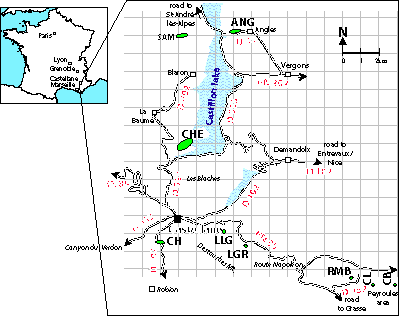
Click on thumbnail to enlarge the image.
Figure 1: Geographical situation of localities mentioned in the Castellane area (Alpes de Haute-Provence, southeast France). The positions of the main areas of investigation and of some areas with a historical significance are shown.
Key: ANG = Angles (see , 1979, p. 18-20); CB = Collet des Boules; CH = Chamateuil; CHE = Cheiron; CL = Clausson; LGR = La Garde; LLG = La Lagne; RMB = Ravin de Mal Bouisset; SAM = Source de l'Asse de Moriez (see also , 1979, p. 19). The following localities (mentioned by , 1829) are not on the map: Lates (department of Var; 5-6 km east of Peyroules), plateau of Gréolières (east of Castellane, between Castellane and Roquestron, department of Var). Other areas not indicated on the map: PE = Pas d'Escale is near Majastres, approximately 8-10 km northwest of Blieux and ALL = Les Allaves, is approximately 25 km west of Castellane.
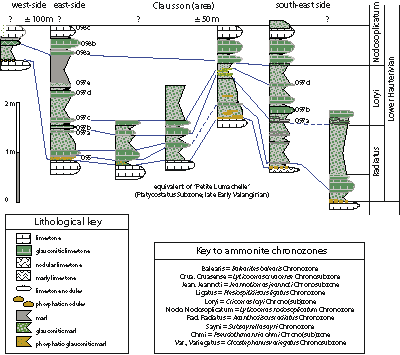
Click on thumbnail to enlarge the image.
Figure 2: Correlation of sections in the Clausson region (CL; Peyroules area), showing the variations in lithology and thickness of the glauconitic sediments of Early Hauterivian age. Note the absence of a phosphatic basal conglomerate in some sections, and especially the variation in beds CL096 to 097d. The sections figured are sited in approximate accordance with their geographic position, from west to south-east. Note the extreme condensation in the western section which is but 100 m from the first east-side column. The changes in the eastern columns occur over a distance of about 50 m. Vertical scale graduations = 1 m.
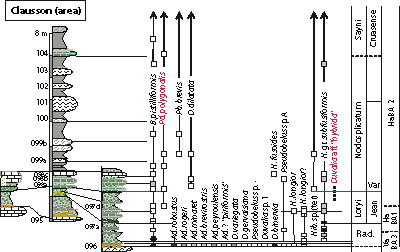
Click on thumbnail to enlarge the image.
Figure 3: Belemnite distribution in the Clausson area
(Peyroules), beds CL095 - CL104a. Three columns are figured, approximately 300 metres apart
(see Fig. 2 ![]() for comparison of distances) showing bed-numbers, their correlation, and their lithology. The distribution of the belemnites in these columns
(with data from the columns depicted in Fig. 2
for comparison of distances) showing bed-numbers, their correlation, and their lithology. The distribution of the belemnites in these columns
(with data from the columns depicted in Fig. 2 ![]() added) is given on the right, along with
ammonite- (sub)zones, and belemnite associations. Key in Figs. 2
added) is given on the right, along with
ammonite- (sub)zones, and belemnite associations. Key in Figs. 2 ![]() and 4
and 4 ![]() . Scale bar graduations = 1 m. The following species were collected as free material below the base of the glauconitic succession: Duvalia gr.
dilatata (), Duvalia cf. maioriana
() or Duvalia sp. 2 (= D. clapiti -unpublished-: nom. nud.), Duvalia aff. "hybrida ()", and Duvalia sp. 4.
. Scale bar graduations = 1 m. The following species were collected as free material below the base of the glauconitic succession: Duvalia gr.
dilatata (), Duvalia cf. maioriana
() or Duvalia sp. 2 (= D. clapiti -unpublished-: nom. nud.), Duvalia aff. "hybrida ()", and Duvalia sp. 4.
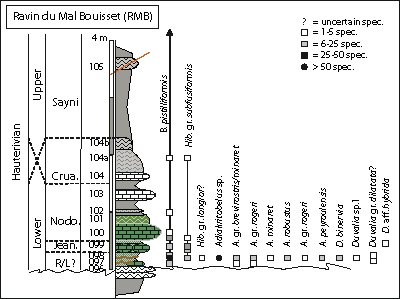
Click on thumbnail to enlarge the image.
Figure 4: Valanginian-Hauterivian in the Ravin du Mal Bouisset
(RMB) near Clausson area (see Fig. 1 ![]() ). Indicated are (sub-)stages, ammonite zones,
bed-numbers, lithology and belemnite distribution. Scale bar indicated (1 m
interval). Key: R/L? = Acanthodiscus radiatus or Crioceratites loryi Zone, for explanation of other ammonite zone abbreviations
(see Fig. 2
). Indicated are (sub-)stages, ammonite zones,
bed-numbers, lithology and belemnite distribution. Scale bar indicated (1 m
interval). Key: R/L? = Acanthodiscus radiatus or Crioceratites loryi Zone, for explanation of other ammonite zone abbreviations
(see Fig. 2 ![]() for key). Scale bar graduations = 1 m.
for key). Scale bar graduations = 1 m.
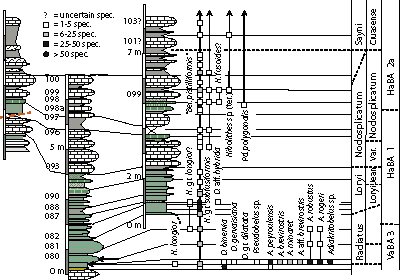
Click on thumbnail to enlarge the image.
Figure 5: Correlation of three field-sections in the Collet des Boules: beds CB078 to CB100/103?. Lithology (see
Figs. 2 ![]() and 4
and 4 ![]() for key), bed-numbers, belemnite distribution, ammonite (sub-)zones, and belemnite associations are shown. Scale bar graduations = 1 m. Key: A. = Adiakritobelus, Bel. =
Belemnites, D. = Duvalia, H. = Hibolithes, Pd. = Pseudoduvalia.
for key), bed-numbers, belemnite distribution, ammonite (sub-)zones, and belemnite associations are shown. Scale bar graduations = 1 m. Key: A. = Adiakritobelus, Bel. =
Belemnites, D. = Duvalia, H. = Hibolithes, Pd. = Pseudoduvalia.
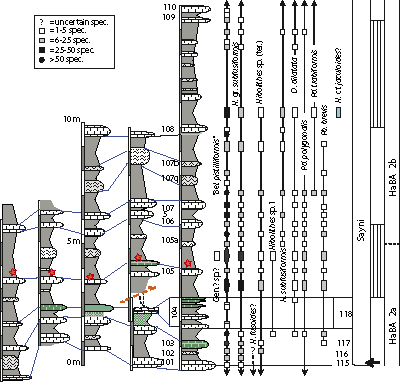
Click on thumbnail to enlarge the image.
Figure 6: Correlation of five field-sections in the Collet des Boules area:
beds CB101 to CB109/110, all within approximately 100 meters of each other. Indicated are lithology (key in
Fig. 2 ![]() ), bed-numbers, belemnite distribution, bed-numbers sensu ,
2002 (beds 115-118 on right), ammonite zones, sequences, and belemnite associations. Black arrow indicates position of (first?) occurrence of Subsaynella sayni (after ,
2002). Key: Bel. =
Belemnites, D. = Duvalia, Gen. = Genus, H. = Hibolithes, Pb. =
Pseudobelus, Pd. = Pseudoduvalia. Red star indicates occurrence of
Isocrinus peyroulensis (). Scale bar graduations = 1 m.
), bed-numbers, belemnite distribution, bed-numbers sensu ,
2002 (beds 115-118 on right), ammonite zones, sequences, and belemnite associations. Black arrow indicates position of (first?) occurrence of Subsaynella sayni (after ,
2002). Key: Bel. =
Belemnites, D. = Duvalia, Gen. = Genus, H. = Hibolithes, Pb. =
Pseudobelus, Pd. = Pseudoduvalia. Red star indicates occurrence of
Isocrinus peyroulensis (). Scale bar graduations = 1 m.
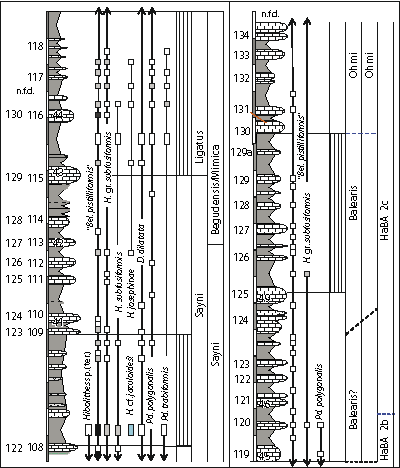
Click on thumbnail to enlarge the image.
Figure 7: Late Hauterivian sequences in the Collet des Boules (beds CB108-134) with bed-numbers, lithology (key in
Fig. 2 ![]() ), belemnite ranges, sequences, and ammonite (sub)zones. Abbreviations used: Bel. =
Belemnites; D. = Duvalia; H. = Hibolithes; Pd. = Pseudoduvalia. Bed numbers after
(1995, beds: 40 to 49), et alii,
1999, , 2002 (beds 122 to 130), pers. obs. (beds: CB108 to CB134). Note that
(1995) indicated
Balearites sp. to occur in bed 45 (= 119). Scale bar graduations = 1 m.
), belemnite ranges, sequences, and ammonite (sub)zones. Abbreviations used: Bel. =
Belemnites; D. = Duvalia; H. = Hibolithes; Pd. = Pseudoduvalia. Bed numbers after
(1995, beds: 40 to 49), et alii,
1999, , 2002 (beds 122 to 130), pers. obs. (beds: CB108 to CB134). Note that
(1995) indicated
Balearites sp. to occur in bed 45 (= 119). Scale bar graduations = 1 m.
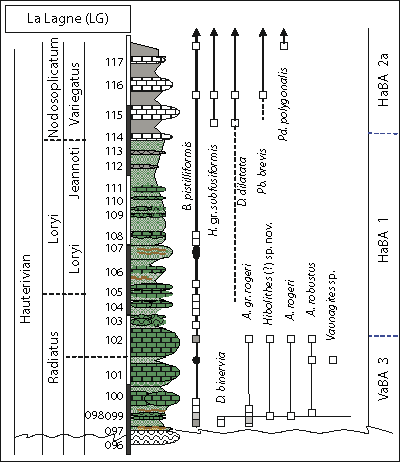
Click on thumbnail to enlarge the image.
Figure 8: Valanginian-Hauterivian section in the La Lagne area. Indicated are stage, ammonite (sub)zones, bed-numbers, lithology and belemnite distribution. Key to lithology and abbreviations in
Figs. 2 ![]() and 4
and 4 ![]() . Scale bar graduations = 1 m.
. Scale bar graduations = 1 m.
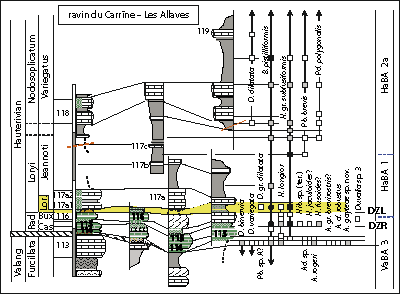
Click on thumbnail to enlarge the image.
Figure 9: Comparison of lithology and belemnite distribution in strata of Valanginian–Hauterivian age in the Les Allaves area
(between Les Allaves profile and the Ravin du Carrîne (southwest of Les Allaves). In columns to the left of the seven profiles are stages, ammonite zones
(modified after: et alii, 1991; ,
1995; pers. obs.) and bed-numbers
(modified after , 1995). Abbreviations used: Ad. = Adiakritobelus; B. =
Belemnites; Bux. = Leopoldia buxtorfi Subzone sensu & ,
1992; Cas = Breistrofferella castellanensis Subzone; D. =
Duvalia; H. = Hibolithes; Pb. = Pseudobelus; Pd. = Pseudoduvalia; Valang. =
Valanginian. See Figs. 2 ![]() and 4
and 4 ![]() for key to lithology and abbreviations. Scale bar graduations = 1 m.
for key to lithology and abbreviations. Scale bar graduations = 1 m.
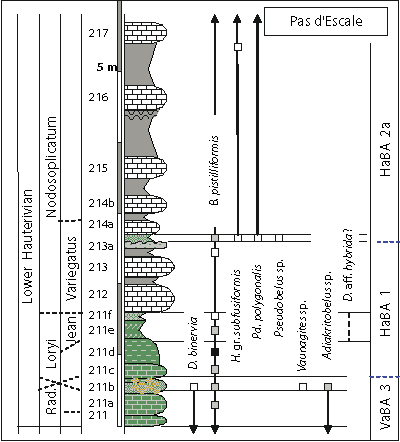
Click on thumbnail to enlarge the image.
Figure 10: Lower Hauterivian sequence in the Pas d'Escale area. Indicated on the left are stages, ammonite (sub)zones, bed-numbers (modified after ,
1994; ,
1995), and lithology, belemnite distribution and zonation on right. For abbreviations see
Figs. 2 ![]() and 4
and 4 ![]() . Free specimens from glauconitic beds include: Duvalia
sp. 1 (?) and
Adiakritobelus rogeri (, 1952). Scale bar graduations = 1 m.
. Free specimens from glauconitic beds include: Duvalia
sp. 1 (?) and
Adiakritobelus rogeri (, 1952). Scale bar graduations = 1 m.
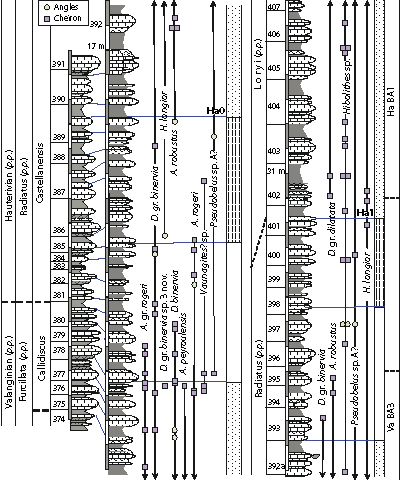
Click on thumbnail to enlarge the image.
Figure 11: Valanginian-Hauterivian boundary and lowermost Hauterivian beds in the Cheiron section. Bed-numbers according to their equivalents in the Angles Valanginian Hypostratotype. Indicated are: stages, ammonite zonation (zones and subzones), bed-numbers, lithology (key in
Fig. 2 ![]() ), sequences (Va6 (p.p.), Ha0 (new sequence), and Ha1), and belemnite distribution (from Cheiron and Angles both). Key: A. = Adiakritobelus, D. = Duvalia, H. =
Hibolithes. Small triangle indicates occurrence of Pygope. Scale bar graduations = 1 m.
), sequences (Va6 (p.p.), Ha0 (new sequence), and Ha1), and belemnite distribution (from Cheiron and Angles both). Key: A. = Adiakritobelus, D. = Duvalia, H. =
Hibolithes. Small triangle indicates occurrence of Pygope. Scale bar graduations = 1 m.
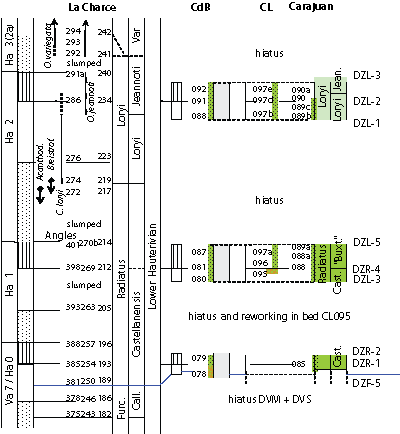
Click on thumbnail to enlarge the image.
Figure 12: Correlation of ammonite distribution in Lower Hauterivian deep-water deposits (Vocontian Basin: La Charce, bed-numbers after (243-294) and (182-242); Angles (375-401)) and shallow depositional areas (glauconitic platform deposits of Peyroules and platform "type section" of
Carajuan, see & ,
1992). Some stratigraphically important ammonite species and genera are indicated
(after , 1995;
et alii, 1996; ,
1996; , 2002). Bed-numbers refer to calcareous beds only. Abbreviations used: Acanthod. =
Acanthodiscus; Breistrof. = Breistrofferella; Call. = Teschenites callidiscus Subzone; C. = Crioceratites; Furc. = Criosarasinella furcillata Zone; L. = Lyticoceras; O. = Olcostephanus; S. =
Subsaynella. Key in Figs. 2 ![]() and 4
and 4 ![]() .
.
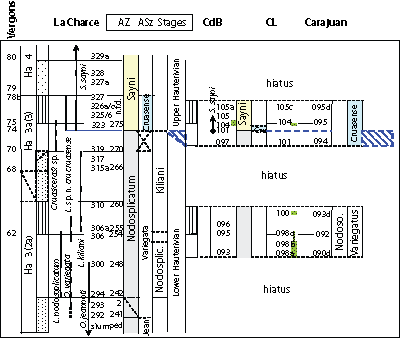
Click on thumbnail to enlarge the image.
Figure 13: Correlation of ammonite distribution in Lower Hauterivian deep-water deposits (Vocontian Basin; La Charce section, bed-numbers after (292-329a) and (241-275); Vergons section after ,
1995) and shallow depositional areas. Ammonite data
after , 1995, et alii,
1996, , 1996, & ,
1999,
and , 2002. A correlation is indicated to the platform "type section" of Carajuan ( & ,
1992). Bed-numbers refer to calcareous beds only. Sequences (Ha 3, etc. modified after & ,
1992). Cruasiceras? sp. and/or Lyticoceras sp. nov. (in et alii,
1996) could be conspecific with Lyticoceras kiliani & ,
1999. Abbreviations used: Cru. = Cruasiceras; Cru. = Lyticoceras cruasense Subzone; L. = Lyticoceras;
n.f.d. = no
further data; O. = Olcostephanus; S. =
Subsaynella. Key in Figs. 2 ![]() and 4
and 4 ![]() .
.
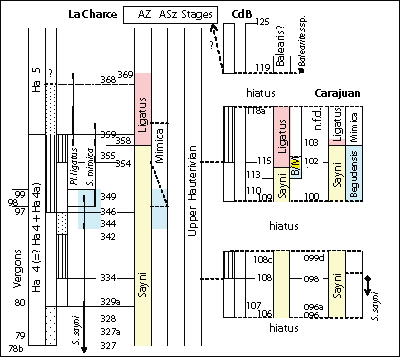
Click on thumbnail to enlarge the image.
Figure 14: Correlation of ammonite distribution in Late Hauterivian deep-water deposits (Vocontian Basin). La Charce (bed-numbers after et alii,
1993: 327-368; note that bed-numbers between sections depicted on p. 49 and 51 are not comparable,
e.g. bed 342-364 on p. 49 = bed 340-359 on p.
51), Vergons (after et alii, 1993, ,
1995), and shallow water deposits (glauconitic platform deposits of Peyroules and "type section" of Carajuan,
& , 1992). Bed-numbers refer to calcareous beds only. Sequences modified after & ,
1992. Some stratigraphically important ammonite species and genera are indicated after: et alii,
1993, 1996; ,
1995; , 2002. Light bluish area indicates possible occurrence of Subsaynella begudensis (indicated as Subsaynella sayni in et alii,
1993). The interval between beds 329a and 359 appears to correlate with two sequences in the platform deposits. Abbreviations used: B. =
S. begudensis; M. = S. mimica; Pl. = Plesiospitidiscus; S. =
Subsaynella. Key in Figs. 2 ![]() and 4
and 4 ![]() .
.
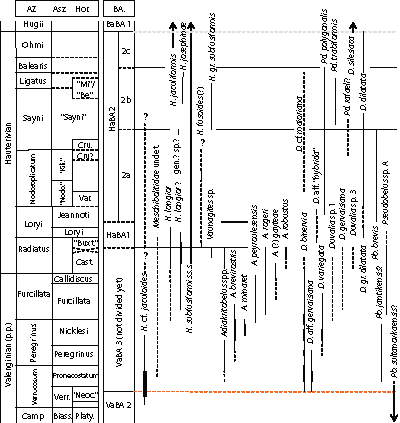
Click on thumbnail to enlarge the image.
Figure 15: Distribution of belemnites in Late Valanginian to Hauterivian age strata in the investigated areas. Ammonite zonation modified after et alii, 2006 (ammonite zones between "" are not yet accepted). Belemnite associations after & , 2002; & , 2004, and data presented herein. Possible zonal belemnite species are in red. More abundant occurrences are indicated by thicker lines. Broken lines indicate approximate range of species. Abbreviations used: AZ = Ammonite zones; Biass. = Karakaschiceras biassalensis; "Buxt." = Leopoldia buxtorfi Horizon sensu & , 1992; Camp. = Busnardoites campylotoxus; Cast. = Breistrofferella castellanensis; Cru? = beds with Cruasiceras? sp. (in et alii, 1993); Cru. = Lyticoceras cruasense; "Kili." = Lyticoceras kiliani sensu & , 1999; "Mi/Be." = Subsaynella mimica resp. Subsaynella begudensis Horizon sensu et alii, 1999; "Neoc." = Neocomites neocomiensis Horizon sensu & , 1993; "Nodo." = Lyticoceras nodosoplicatum Subzone sensu & , 1999; Platy. = Eristavites platycostatus; Var. = Olcostephanus variegatus; Verr. = Saynoceras verrucosum.

Click on thumbnail to enlarge the image.
Figure 16: Vergol area: a Late Valanginian succession. Note that the slumps below bed 174 and above 169b are not to scale. Bed numbers correlated with those of beds 339-376 at Angles, are shown, along with lithology, sequences, and ammonite zonations (based on correlations). The FO, LO, or single occurrences of belemnite species are indicated. Key in
Figs. 2 ![]() and 4
and 4 ![]() . Scale bar graduations = 1 m.
. Scale bar graduations = 1 m.
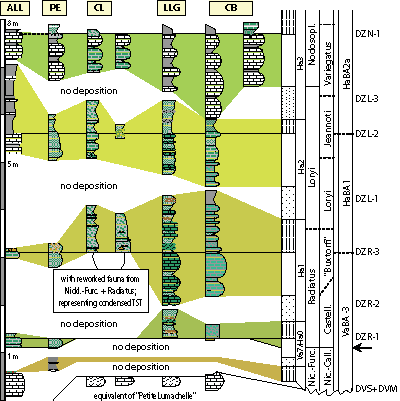
Click on thumbnail to enlarge the image.
Figure 17: Correlation of Lower Hauterivian sedimentary rocks. Arrow indicates position of Valanginian-Hauterivian boundary. Abbreviations: ALL = Les Allaves; CB = Collet des Boules; CL = Clausson; Nic. = Olcostephanus nicklesi Zone; PE = Pas d'Escale. Lithology, sequences, ammonite (sub)zones, belemnite associations (VaBA-3, HaBA1, and HaBA2a), and discontinuities (DVS, DZR, DZL, and DZN) are depicted. See text for explanation. Keys to lithology and abbreviations in
Figs. 2 ![]() and 4
and 4 ![]() . Scale bar graduations = 1 m.
. Scale bar graduations = 1 m.

Click on thumbnail to enlarge the image.
Plate 1 (Valanginian-Hauterivian; Hibolithes):
Fig. 1.- Belemnites pistilliformis , RGM 288.898, ALL121, Lyticoceras nodosplicatum Zone.
Figs. 2-3.- Hibolithes fusoides (,
1822), RGM 288.483, CL099top, Lyticoceras nodosplicatum Zone.
Figs. 4-5.- Hibolithes fusoides (,
1822), RGM 214.809, Clausson (west), free specimen.
Figs. 6-7.- Hibolithes fusoides (,
1822), RGM 214.810, Clausson (west), free specimen.
Figs. 8-9.- Hibolithes sp. (ter.), RGM 288.296a, CB107-107a, Subsaynella sayni Zone.
Figs. 10-11.- Hibolithes sp. (ter.), RGM 288.296b, CB107-107a, Subsaynella sayni Zone.
Figs. 12-13.- Hibolithes sp. 1, RGM 288.295, CB106-107, Subsaynella sayni Zone.
Figs. 14-15.- Hibolithes subfusiformis (,
1829), RGM 288.764, La Bâtie, LB113-114, "Subsyanella mimica" Subzone.
Figs. 16-17.- Hibolithes subfusiformis (,
1829), RGM 288.307a, CB107a-108, Subsaynella sayni Zone.
Figs. 17-19.- Hibolithes sp. (ter.), RGM 288.481, CL097-098, top Acanthodiscus radiatus/base Crioceratites loryi Zone.
Figs. 20-21.- Hibolithes gr. subfusiformis , RGM 288.333, CB104a-105, Lyticoceras cruasense Zone.
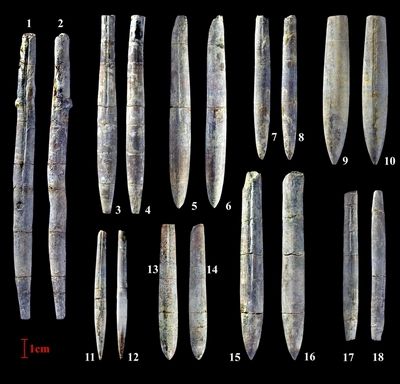
Click on thumbnail to enlarge the image.
Plate 2 (Valanginian-Hauterivian; Hibolithes):
Figs. 1-2.- Hibolithes longior , 1913, RGM 288.328, CB079, V/H boundary.
Figs. 3-4.- Hibolithes longior ,
1913, RGM 288.835, ALL116, top Acanthodiscus radiatus Zone ("Leopoldia buxtorfi Subzone").
Figs. 5-6.- Hibolithes longior? ,
1913, RGM 288.467, CL096, Acanthodiscus radiatus Zone.
Figs. 7-8.- Hibolithes longior ,
1913, RGM 288.474, CL097c-d, Crioceratites loryi Zone.
Figs. 9-10.- Hibolithes jaculoides ,
1937, RGM 560.599, Cheiron, Karakaschiceras pronecostatum Subzone.
Figs. 11-12.- Hibolithes longior? ,
1913 (juv.), RGM 288.352, CB079, V/H boundary.
Figs. 13-14.- Hibolithes longior? ,
1913, RGM 288.332, CB085-087, Crioceratites loryi Zone.
Figs. 15-16.- Hibolithes longior? ,
1913, RGM 288.331, CB085-087, Crioceratites loryi Zone.
Figs. 17-18.- Hibolithes longior ,
1913, RGM 560.609, Angles, ANG386, Acanthodiscus radiatus Zone.
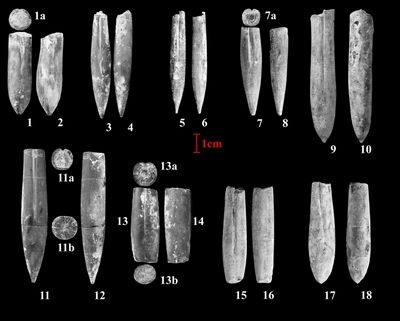
Click on thumbnail to enlarge the image.
Plate 3 (Valanginian-Hauterivian; Adiakritobelus):
Figs. 1-2.- Adiakritobelus? sp. (ter.), RGM 214.706, Angles, ANG337-338, Varlheideites peregrinus Subzone.
Fig. 1a.- Cross-section in alveolar opening.
Figs. 3-4.- Adiakritobelus brevirostris (,
1829), RGM 214.714, Vergol, VGL149e-150, Olcostephanus nicklesi Subzone.
Figs. 5-6.- Adiakritobelus brevirostris (,
1829), RGM 214.731, Vergol, VGL154b-155, Olcostephanus nicklesi Subzone.
Figs. 7-8.- Adiakritobelus brevirostris (,
1829), RGM 214.780, CL095, V/H boundary.
Fig. 7a.- Cross-section in alveolar opening.
Figs. 9-10.- Adiakritobelus minaret (,
1829), RGM 214.990, CL095, V/H boundary.
Figs. 11-12.- Adiakritobelus minaret (,
1829), RGM 214.741, Angles, ANG358-359, Olcostephanus nicklesi Subzone.
Fig. 11a.- Cross-section in alveolar opening.
Fig. 11b.- Cross-section near maximum outline.
Figs. 13-14.- Adiakritobelus minaret (,
1829), RGM 214.715, Vergol, VGL154-158, Olcostephanus nicklesi Subzone.
Fig. 13a.- Cross-section in alveolar opening.
Fig. 13b.- Cross-section in apical part.
Figs. 15-16.- Adiakritobelus minaret (,
1829), RGM 214.782, CB079, V/H boundary.
Figs. 17-18.- Adiakritobelus? sp., RGM 214.850, CL095, V/H-boundary.
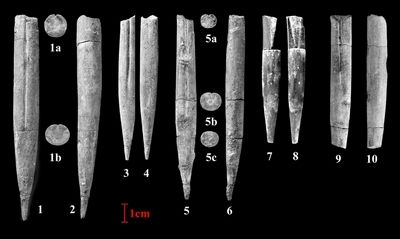
Click on thumbnail to enlarge the image.
Plate 4 (Valanginian-Hauterivian; Adiakritobelus):
Figs. 1-2.- Adiakritobelus peyroulesensis sp. nov. holotype, RGM 214.798, CB079, V/H boundary.
Fig. 1a.- Cross-section in alveolar opening.
Fig. 1b.- Cross-section near end of alveolar groove.
Figs. 3-4.- Adiakritobelus peyroulesensis sp. nov. paratype, RGM 214.787, CB078, V/H boundary.
Figs. 5-6.- Adiakritobelus peyroulesensis sp. nov. topotype, RGM 214.796, CB079, V/H boundary.
Fig. 5a.- Cross-section in alveolar opening.
Fig. 5b.- Cross-section near maximum diameter.
Fig. 5c.- Cross-section in apical part
Figs. 7-8.- Adiakritobelus peyroulesensis sp. nov. topotype, RGM 214.758, Vergol, VGL170, Criosarasinella furcillata Zone.
Figs. 9-10.- Adiakritobelus cf. peyroulesensis sp. nov. topotype, RGM 214.895, CL095, V/H boundary.
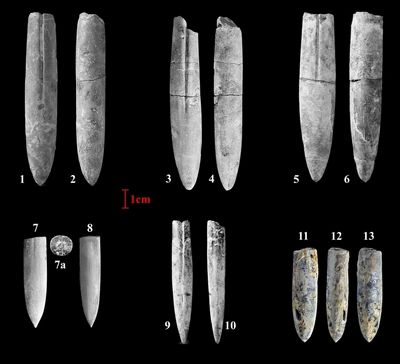
Click on thumbnail to enlarge the image.
Plate 5 (Valanginian-Hauterivian; Adiakritobelus):
Figs. 1-2.- Adiakritobelus robustus (,
1841) topotype, RGM 214.803, CL095, V/H boundary.
Figs. 3-4.- Adiakritobelus robustus (,
1841) topotype, RGM 214.913, CL095, V/H boundary.
Figs. 5-6.- Adiakritobelus robustus (,
1841), RGM 214.804, LLG102, V/H-boundary.
Figs. 7-8.- Adiakritobelus cf. robustus (,
1841), RGM 214.778, Angles, ANG393, Acanthodiscus radiatus Zone.
Fig. 7a.- Cross-section in alveolar part.
Figs. 9-10.- Adiakritobelus robustus (,
1841) (imm.) topotype, RGM 214.989, CB079, V/H boundary.
Figs. 11-13.- Adiakritobelus cf. robustus? (,
1841), RGM 361.675, Tornajo (southeastern Spain), B130 (-131), late Teschenites callidiscus (?) Subzone.
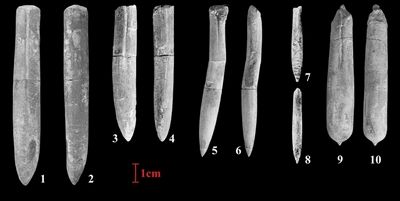
Click on thumbnail to enlarge the image.
Plate 6 (Valanginian-Hauterivian; Adiakritobelus):
Figs. 1-2.- Adiakritobelus rogeri (,
1952) topotype, RGM 214.926, CL095, V/H boundary.
Figs. 3-4.- Adiakritobelus rogeri (,
1952) topotype, RGM 214.897, CL095, V/H boundary.
Figs. 5-6.- Adiakritobelus rogeri (,
1952) imm. topotype, RGM 214.910, CL095, V/H boundary.
Figs. 7-8.- Adiakritobelus sp. (gr. rogeri (,
1952)) (juv.), RGM 214.963, Vergol, VGL119-124, Karakaschiceras pronecostatum Subzone.
Figs. 9-10.- Adiakritobelus (?) gayteae sp. nov. holotype, RGM 214.909, CL095, V/H boundary.
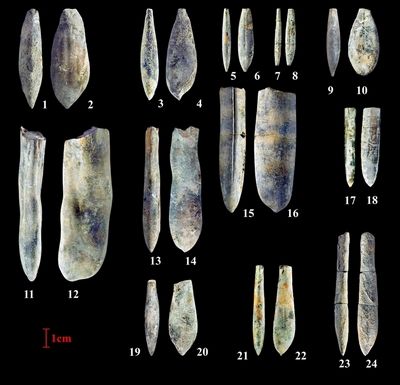
Click on thumbnail to enlarge the image.
Plate 7 (Valanginian-Hauterivian; Duvalia):
Figs. 1-2.- Duvalia binervia (, 1829) gerontic, RGM 288.571, CL095, V/H boundary.
Figs. 3-4.- Duvalia binervia (,
1829) topotype, RGM 560.593, CHE361-362, Criosarasinella furcillata Zone.
Figs. 5-6.- Duvalia binervia (,
1829) juv./imm. topotype, RGM 560.588, CHE342-a, Olcostephanus nicklesi Subzone.
Figs. 7-8.- Duvalia sp. juv. (gr. binervia? (,
1829)), RGM 288.343, CB085, Crioceratites loryi Zone.
Figs. 9-10.- Duvalia gr. binervia (,
1829), RGM 288.526, CL095, V/H boundary.
Figs. 11-12.- Duvalia variegata (,
1829) gerontic topotype, RGM 288.637, CL095, V/H boundary.
Figs. 13-14.- Duvalia variegata (,
1829) topotype, RGM 288.636, CL095, V/H-boundary.
Figs. 15-16.- Duvalia maioriana ,
1965, RGM 288.648, Clausson (west), free specimen.
Figs. 17-18.- Duvalia maioriana ,
1965, RGM 345.565, Río Argos (Spain), A43-44, Lyticoceras nodosoplicatum Zone.
Figs. 19-20.- ?Duvalia sp. 1 (imm.), RGM 288.599, CL095, V/H boundary.
Figs. 21-22.- Duvalia sp. 3 (gr. binervia (,
1829)), RGM 288.584, CL095, V/H boundary.
Figs. 23-24.- Duvalia sp. 3 (gr. binervia (,
1829)), RGM 560.590, CHE378mid, Acanthodiscus radiatus Zone.
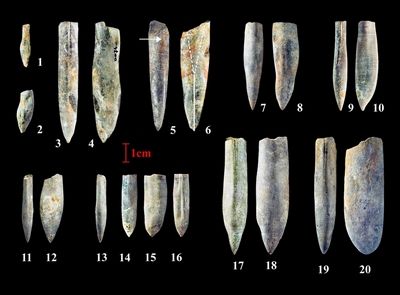
Click on thumbnail to enlarge the image.
Plate 8 (Valanginian-Hauterivian; Duvalia):
Figs. 1-2.- Pseudoduvalia? sp. (ter.?), RGM 288.679, CL095, Clausson (west).
Figs. 3-4.- Duvalia gervaisiana (,
1876), RGM 288.613, CL095, V/H boundary.
Figs. 5-6.- Duvalia sp. 4, RGM 288.645, CL095, Clausson (west). Arrow indicates initiation of alveolar groove.
Figs. 7-8.- Pseudoduvalia polygonalis (,
1827), RGM 288.677, CL102-104?, Lyticoceras nodosoplicatum? Zone.
Figs. 9-10.- Pseudoduvalia polygonalis (,
1827), RGM 288.654, CL106-107, Subsaynella sayni Zone.
Figs. 11-13.- Pseudoduvalia rafaeli? (,
1965), RGM 288.777, La Bâtie, Subsaynella sayni Zone (free specimen).
Figs. 14-16.- Pseudoduvalia polygonalis (,
1827), RGM 288.348, CB091, Jeannoticeras jeannoti Subzone.
Figs. 17-18.- Duvalia aff. "hybrida (,
1841)", RGM 288.347, CB087, Crioceratites loryi Zone.
Figs. 19-20.- Duvalia maioriana ,
1965, RGM 288.649, Clausson (west), free specimen.
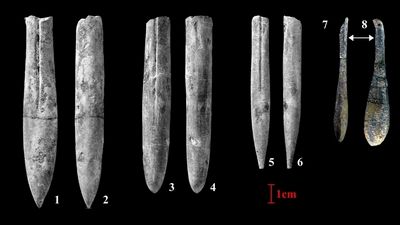
Click on thumbnail to enlarge the image.
Plate 9:
Figs. 1-2.- Adiakritobelus robustus (,
1841) topotype, RGM 288.357, CL095, V/H-boundary.
Figs. 3-4.- Adiakritobelus rogeri (,
1952) topotype, RGM 214.998, CL095, V/H-boundary.
Figs. 5-6.- Adiakritobelus peyroulesensis sp. nov. topotype, RGM 215.000, CL095, V/H-boundary.
Figs. 7-8.- Duvalia binervia (,
1829) topotype, RGM 560.594, CHE345, Olcostephanus nicklesi Subzone.